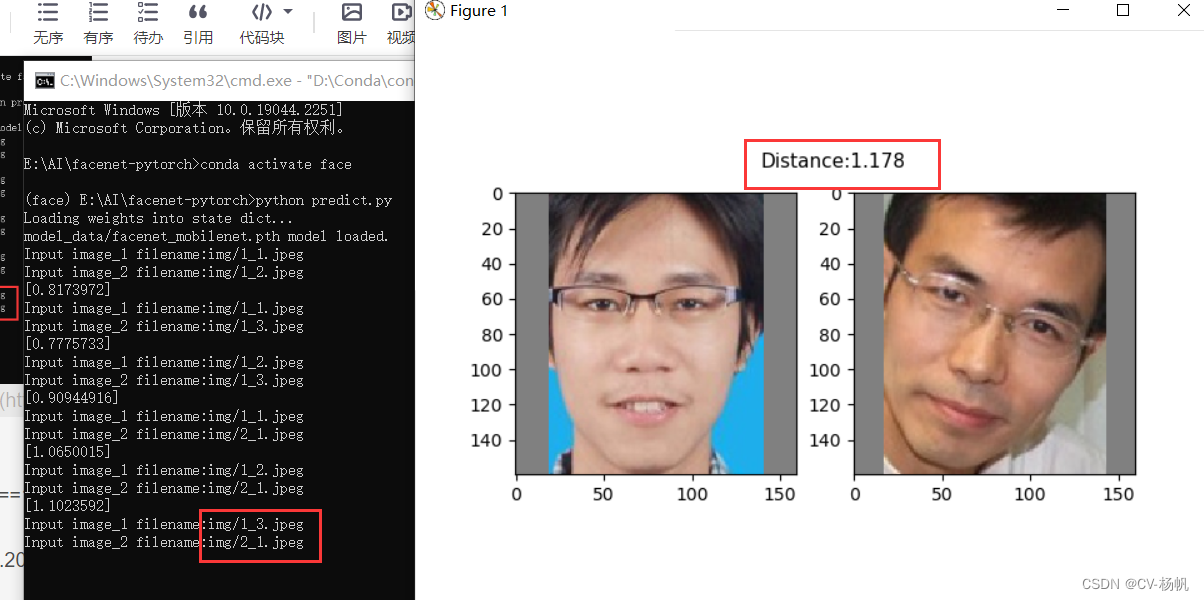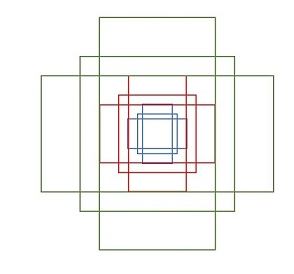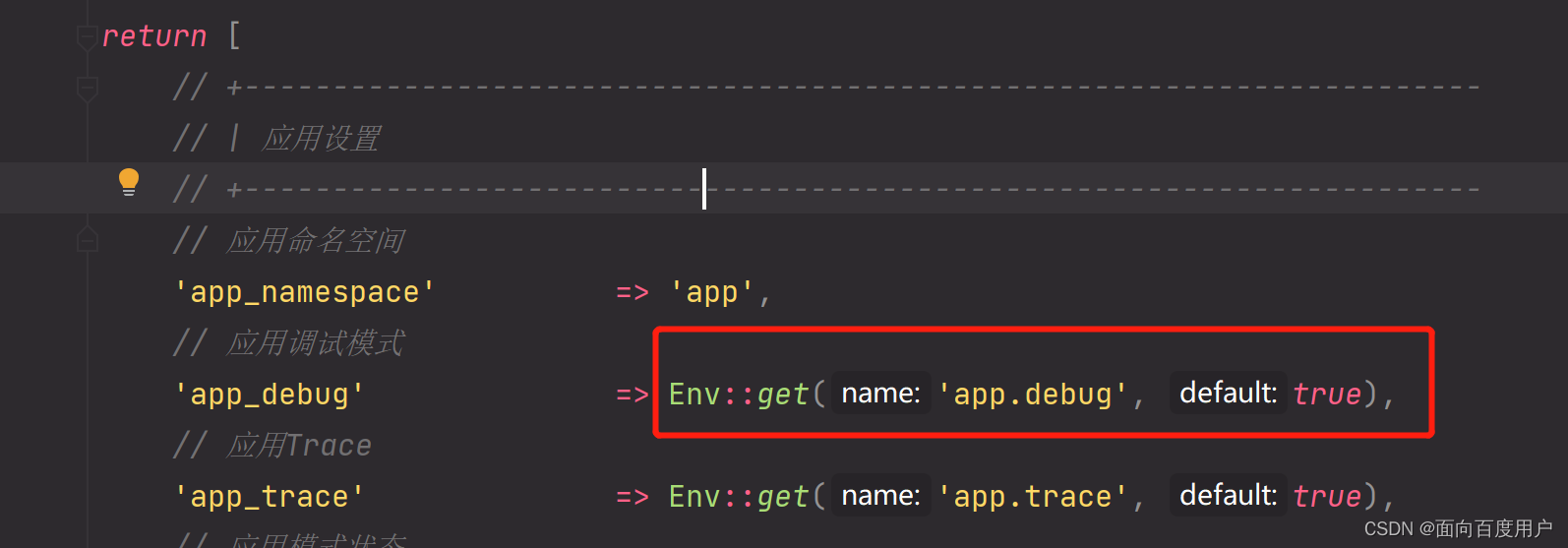目录
Spring简介
Spring体系结构
IOC_控制反转思想
IOC_自定义对象容器
IOC_Spring实现IOC
IOC_Spring容器类型
容器实现类
IOC_对象的创建方式
使用构造方法
使用工厂类的方法
使用工厂类的静态方法
IOC_对象的创建策略
IOC_对象的销毁时机
IOC_生命周期方法
IOC_获取Bean对象的方式
通过id/name获取
通过类型获取
通过类型+id/name获取
DI_什么是依赖注入
DI_依赖注入方式
Setter注入
构造方法注入
自动注入
DI_依赖注入类型
注入bean类型
注入基本数据类型
注入List集合
注入Set集合
注入Map集合
注入Properties对象
注解实现IOC_准备工作
注解实现IOC_@Component
注解实现IOC_@Repository、@Service、@Controller
注解实现IOC_@Scope
注解实现IOC_@Autowired
注解实现IOC_@Qualifier
注解实现IOC_@Value
注解实现IOC_@Configuration
注解实现IOC_@ComponentScan
注解实现IOC_@PropertySource
注解实现IOC_@Bean
注解实现IOC_@Import
Spring整合MyBatis_搭建环境
创建maven项目,引入依赖。
Spring整合MyBatis_编写配置文件
1、编写数据库配置文件db.properties
Spring整合MyBatis_准备数据库和实体类
准备数据库
准备实体类
Spring整合MyBatis_编写持久层接口和service类
编写持久层接口
编写service类
Spring整合MyBatis_Spring整合Junit进行单元测试
Spring整合MyBatis_自动创建代理对象
SpringAOP_AOP简介
SpringAOP_AOP相关术语
SpringAOP_AOP入门
SpringAOP_通知类型
SpringAOP_切点表达式
SpringAOP_多切面配置
SpringAOP_注解配置AOP
SpringAOP_原生Spring实现AOP
SpringAOP_SchemaBased实现AOP
Spring事务_事务简介
Spring事务_Spring事务管理方案
Spring事务_Spring事务管理器
Spring事务_事务控制的API
Spring事务_事务的相关配置
Spring事务_事务的传播行为
Spring事务_事务的隔离级别
Spring事务_注解配置声明式事务
Spring简介

Spring是一个开源框架,为简化企业级开发而生。它以IOC(控制 反转)和AOP(面向切面)为思想内核,提供了控制层 SpringMVC、数据层SpringData、服务层事务管理等众多技术,并 可以整合众多第三方框架。 Spring将很多复杂的代码变得优雅简洁,有效的降低代码的耦合 度,极大的方便项目的后期维护、升级和扩展。
Spring官网地址:https://spring.io/
Spring体系结构
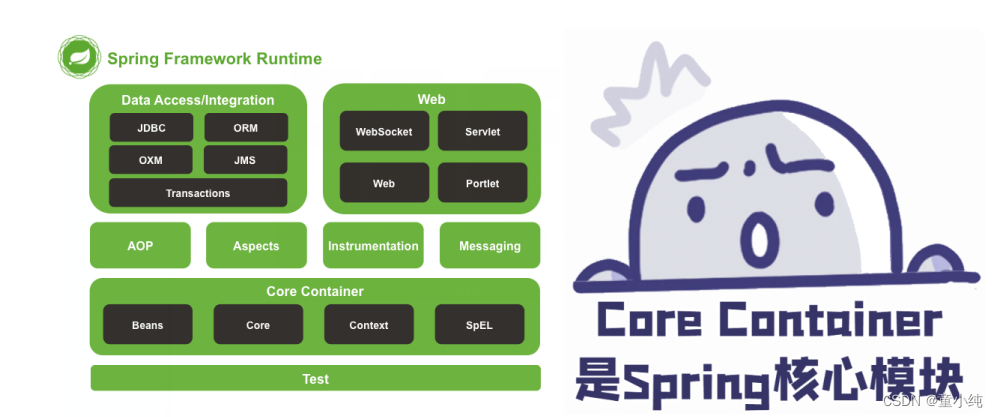
Spring框架根据不同的功能被划分成了多个模块,这些模块可以满 足一切企业级应用开发的需求,在开发过程中可以根据需求有选择 性地使用所需要的模块。
1、Core Container:Spring核心模块,任何功能的使用都离不开该模块,是其他模块建立的基础。
2、Data Access/Integration:该模块提供了数据持久化的相应功能。
3、Web:该模块提供了web开发的相应功能。
4、AOP:提供了面向切面编程实现
5、Aspects:提供与AspectJ框架的集成,该框架是一个面向切面编程框架。
6、Instrumentation:提供了类工具的支持和类加载器的实现,可以在特定的应用服务器中使 用。
7、Messaging:为Spring框架集成一些基础的报文传送应用
8、Test:提供与测试框架的集成
IOC_控制反转思想

IOC(Inversion of Control) :程序将创建对象的权利交给框架。 之前在开发过程中,对象实例的创建是由调用者管理的,代码如下:
public interface StudentDao {// 根据id查询学生Student findById(int id);
}
public class StudentDaoImpl implements StudentDao{@Overridepublic Student findById(int id) {// 模拟从数据库查找出学生return new Student(1,"程序员","北京");}
}
public class StudentService {public Student findStudentById(int id){// 此处就是调用者在创建对象StudentDao studentDao = new StudentDaoImpl();return studentDao.findById(1);}
}这种写法有两个缺点:
1 浪费资源:StudentService调用方法时即会创建一个对象,如果 不断调用方法则会创建大量StudentDao对象。
2 代码耦合度高:假设随着开发,我们创建了StudentDao另一个 更加完善的实现类StudentDaoImpl2,如果在StudentService 中想使用StudentDaoImpl2,则必须修改源码。
而IOC思想是将创建对象的权利交给框架,框架会帮助我们创建对 象,分配对象的使用,控制权由程序代码转移到了框架中,控制权 发生了反转,这就是Spring的IOC思想。而IOC思想可以完美的解决以上两个问题。
IOC_自定义对象容器
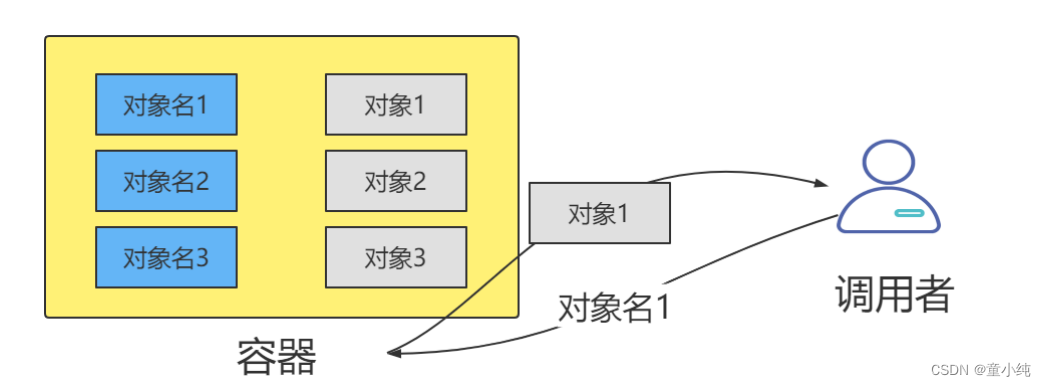
接下来我们通过一段代码模拟IOC思想。创建一个集合容器,先将 对象创建出来放到容器中,需要使用对象时,只需要从容器中获取 对象即可,而不需要重新创建,此时容器就是对象的管理者。
创建实体类
public class Student {private int id;private String name;private String address;// 省略getter/setter/构造方法/tostring
}创建Dao接口和实现类
public interface StudentDao {// 根据id查询学生Student findById(int id);
}
public class StudentDaoImpl implements StudentDao{@Overridepublic Student findById(int id) {// 模拟从数据库查找出学生return new Student(1,"程序员","北京");}
}
public class StudentDaoImpl2 implements StudentDao{@Overridepublic Student findById(int id) {// 模拟根据id查询学生System.out.println("新方法!!!");return new Student(1,"程序员","北京");}
}创建配置文件bean.properties,该文件中定义管理的对象
studentDao=com.itbaizhan.dao.StudentDaoImpl创建容器管理类,该类在类加载时读取配置文件,将配置文件中 配置的对象全部创建并放入容器中。
public class Container {static Map<String,Object> map = new HashMap();static {// 读取配置文件InputStream is = Container.class.getClassLoader().getResourceAsStream("bean.properties");Properties properties = new Properties();try {properties.load(is);} catch (IOException e) {e.printStackTrace();}// 遍历配置文件的所有配置Enumeration<Object> keys = properties.keys();while (keys.hasMoreElements()){String key = keys.nextElement().toString();String value = properties.getProperty(key);try {// 创建对象Object o = Class.forName(value).newInstance();// 将对象放入集合中map.put(key,o);} catch (Exception e) {e.printStackTrace();}}}// 从容器中获取对象public static Object getBean(String key){return map.get(key);}
}创建Dao对象的调用者StudentService
public class StudentService {public Student findStudentById(int id){// 从容器中获取对象StudentDao studentDao = (StudentDao) Container.getBean("studentDao");System.out.println(studentDao.hashCode());return studentDao.findById(id);}
}测试StudentService
public class Test {public static void main(String[] args){StudentService studentService = new StudentService();System.out.println(studentService.findStudentById(1));System.out.println(studentService.findStudentById(1));}
}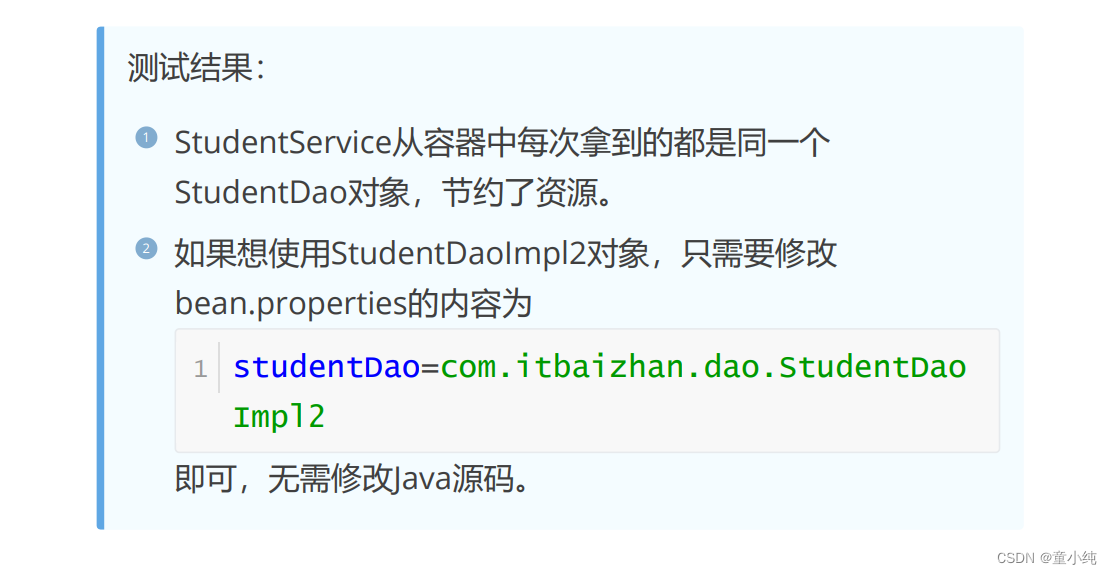
IOC_Spring实现IOC
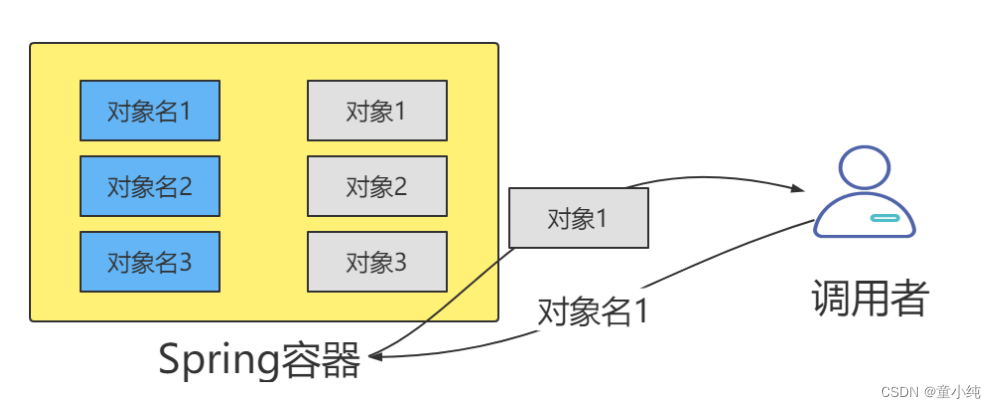
接下来我们使用Spring实现IOC,Spring内部也有一个容器用来管 理对象。
创建Maven工程,引入依赖
<dependencies><dependency><groupId>org.springframework</groupId><artifactId>spring-context</artifactId><version>5.3.13</version></dependency><dependency><groupId>junit</groupId><artifactId>junit</artifactId><version>4.12</version><scope>test</scope></dependency>
</dependencies>创建POJO类、Dao类和接口
public class Student {private int id;private String name;private String address;// 省略getter/setter/构造方法/tostring
}
public interface StudentDao {// 根据id查询学生Student findById(int id);
}
public class StudentDaoImpl implements StudentDao{@Overridepublic Student findById(int id) {// 模拟从数据库查找出学生return new Student(1,"程序员","北京");}
}编写xml配置文件,配置文件中配置需要Spring帮我们创建的对象。
<?xml version="1.0" encoding="UTF-8"?>
<beans xmlns="http://www.springframework.org/schema/beans"xmlns:xsi="http://www.w3.org/2001/XMLSchema-instance"xsi:schemaLocation="http://www.springframework.org/schema/beanshttp://www.springframework.org/schema/beans/spring-beans.xsd"><bean id="studentDao" class="com.itbaizhan.dao.StudentDaoImpl"></bean>
</beans>测试从Spring容器中获取对象。
public class TestContainer {@Testpublic void t1(){// 创建Spring容器ApplicationContext ac = new ClassPathXmlApplicationContext("bean.xml");// 从容器获取对象StudentDao studentDao1 = (StudentDao) ac.getBean("studentDao");StudentDao studentDao2 = (StudentDao) ac.getBean("studentDao");System.out.println(studentDao1.hashCode());System.out.println(studentDao2.hashCode());System.out.println(studentDao1.findById(1));}
} IOC_Spring容器类型 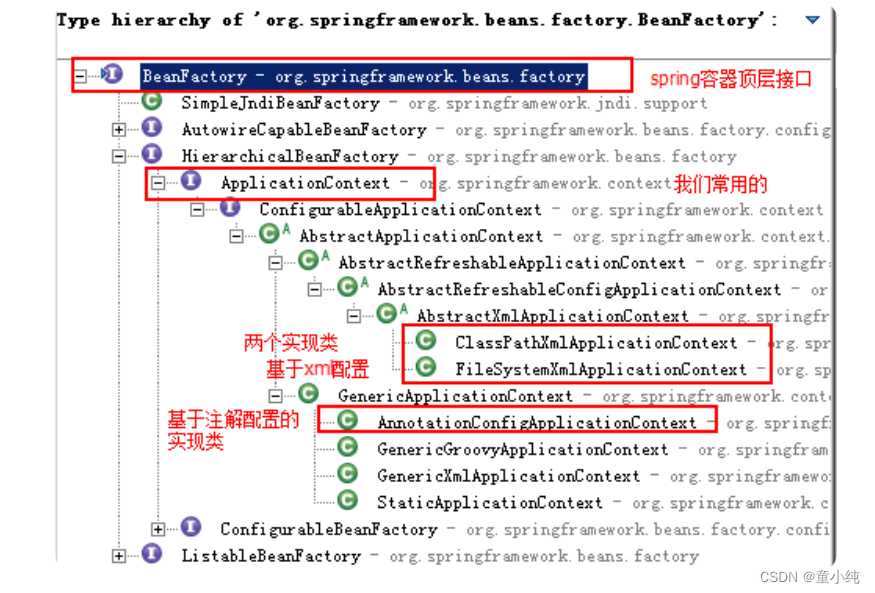 容器接口
容器接口
1、BeanFactory:BeanFactory是Spring容器中的顶层接口,它可 以对Bean对象进行管理。
2、ApplicationContext:ApplicationContext是BeanFactory的子 接口。它除了继承 BeanFactory的所有功能外,还添加了对国际 化、资源访问、事件传播等方面的良好支持。
ApplicationContext有以下三个常用实现类:、
容器实现类
1、ClassPathXmlApplicationContext:该类可以从项目中读取配置文件
2、FileSystemXmlApplicationContext:该类从磁盘中读取配置文件
3、AnnotationConfigApplicationContext:使用该类不读取配置文件,而是会读取注解
@Test
public void t2(){// 创建spring容器// ApplicationContext ac = new ClassPathXmlApplicationContext("bean.xml");ApplicationContext ac = new FileSystemXmlApplicationContext("C:\\Users\\a\\IdeaProjects\\spring_demo\\src\\main\\resources\\bean.xml");// 从容器中获取对象StudentDao userDao = (StudentDao)ac.getBean("studentDao");System.out.println(userDao);System.out.println(userDao.findById(1));
}IOC_对象的创建方式

Spring会帮助我们创建bean,那么它底层是调用什么方法进行创建 的呢?
使用构造方法
Spring默认使用类的空参构造方法创建bean:
// 假如类没有空参构造方法,将无法完成bean的创建
public class StudentDaoImpl implements StudentDao{public StudentDaoImpl(int a){} @Overridepublic Student findById(int id) {// 模拟根据id查询学生return new Student(1,"程序员","北京");}
}使用工厂类的方法
Spring可以调用工厂类的方法创建bean:
1、创建工厂类,工厂类提供创建对象的方法:
public class StudentDaoFactory {public StudentDao getStudentDao(){return new StudentDaoImpl(1);}
}
2 在配置文件中配置创建bean的方式为工厂方式。
<!-- id:工厂对象的id,class:工厂类 -->
<bean id="studentDaoFactory" class="com.itbaizhan.dao.StudentDaoFactory"></bean>
<!-- id:bean对象的id,factory-bean:工厂对象 的id,factory-method:工厂方法 -->
<bean id="studentDao" factorybean="studentDaoFactory" factory-method="getStudentDao"></bean>3 测试
使用工厂类的静态方法
Spring可以调用工厂类的静态方法创建bean:
1 创建工厂类,工厂提供创建对象的静态方法。
public class StudentDaoFactory2 {public static StudentDao getStudentDao2() {return new StudentDaoImpl();}
}
2 在配置文件中配置创建bean的方式为工厂静态方法。
<!-- id:bean的id class:工厂全类名 factory-method:工厂静态方法 -->
<bean id="studentDao" class="com.itbaizhan.dao.StudentDaoFactory2" factory-method="getStudentDao2"></bean>3 测试
IOC_对象的创建策略
 Spring通过配置 中的 scope 属性设置对象的创建策略,共有五种创建策略
Spring通过配置 中的 scope 属性设置对象的创建策略,共有五种创建策略
1、singleton:单例,默认策略。整个项目只会创建一个对象,通过中的 lazy-init 属性可以设置单例对象的创建时机:
lazy-init="false"(默认):立即创建,在容器启动时会创建配 置文件中的所有Bean对象。 lazy-init="true":延迟创建,第一次使用Bean对象时才会创 建。
配置单例策略:
<!-- <bean id="studentDao" class="com.itbaizhan.dao.StudentDaoImpl2" scope="singleton" lazy-init="true"> </bean>-->
<bean id="studentDao" class="com.itbaizhan.dao.StudentDaoImpl2" scope="singleton" lazy-init="false">
</bean>测试单例策略:
// 为Bean对象的类添加构造方法
public StudentDaoImpl2(){System.out.println("创建 StudentDao!!!");
}
@Test
public void t2(){// 创建Spring容器ApplicationContext ac = new ClassPathXmlApplicationContext("bean1.xml");// 从容器获取对象StudentDao studentDao1 = (StudentDao)ac.getBean("studentDao");StudentDao studentDao2 = (StudentDao)ac.getBean("studentDao");StudentDao studentDao3 = (StudentDao)ac.getBean("studentDao");System.out.println(studentDao1.hashCode());System.out.println(studentDao2.hashCode());System.out.println(studentDao3.hashCode());
}2、prototype:多例,每次从容器中获取时都会创建对象。
<!-- 配置多例策略 -->
<bean id="studentDao" class="com.itbaizhan.dao.StudentDaoImpl2" scope="prototype"></bean>
3、request:每次请求创建一个对象,只在web环境有效。
4、session:每次会话创建一个对象,只在web环境有效。
5、gloabal-session:一次集群环境的会话创建一个对象,只在web 环境有效。
IOC_对象的销毁时机

对象的创建策略不同,销毁时机也不同:
singleton:对象随着容器的销毁而销毁。
prototype:使用JAVA垃圾回收机制销毁对象。
request:当处理请求结束,bean实例将被销毁。
session:当HTTP Session最终被废弃的时候,bean也会被销毁掉。
gloabal-session:集群环境下的session销毁,bean实例也将被销毁。
IOC_生命周期方法

Bean对象的生命周期包含创建——使用——销毁,Spring可以配置 Bean对象在创建和销毁时自动执行的方法:
1 定义生命周期方法
public class StudentDaoImpl2 implements StudentDao{// 创建时自动执行的方法public void init(){System.out.println("创建StudentDao!!!");}// 销毁时自动执行的方法public void destory(){System.out.println("销毁StudentDao!!!");}
}2 配置生命周期方法
<!-- init-method:创建对象时执行的方法 destroy-method:销毁对象时执行的方法 -->
<bean id="studentDao" class="com.itbaizhan.dao.StudentDaoImpl2" scope="singleton"init-method="init" destroy-method="destory"></bean>3 测试
@Test
public void t3(){// 创建Spring容器ClassPathXmlApplicationContext ac = new ClassPathXmlApplicationContext("bean1.xml");// 销毁Spring容器,ClassPathXmlApplicationContext才有销毁容器的方法ac.close();
}IOC_获取Bean对象的方式

Spring有多种获取容器中对象的方式:
通过id/name获取
配置文件
<bean name="studentDao" class="com.itbaizhan.dao.StudentDaoImpl2"></bean>
<bean id="studentDao" class="com.itbaizhan.dao.StudentDaoImpl2"></bean>
获取对象
StudentDao studentDao = (StudentDao) ac.getBean("studentDao");通过类型获取
配置文件
<bean name="studentDao" class="com.itbaizhan.dao.StudentDaoImpl2"></bean>获取对象
StudentDao studentDao2 = ac.getBean(StudentDao.class);
通过类型+id/name获取
虽然使用类型获取不需要强转,但如果在容器中有一个接口的多个 实现类对象,则获取时会报错,此时需要使用类型+id/name获取
配置文件
<bean name="studentDao" class="com.itbaizhan.dao.StudentDaoImpl2"></bean>
<bean name="studentDao1" class="com.itbaizhan.dao.StudentDaoImpl"></bean>获取对象
StudentDao studentDao2 = ac.getBean("studentDao",StudentDao.class);DI_什么是依赖注入

依赖注入(Dependency Injection,简称DI),它是Spring控制反 转思想的具体实现。 控制反转将对象的创建交给了Spring,但是对象中可能会依赖其他 对象。比如service类中要有dao类的属性,我们称service依赖于 dao。之前需要手动注入属性值,代码如下:
public interface StudentDao {Student findById(int id);
}
public class StudentDaoImpl implements StudentDao{@Overridepublic Student findById(int id) {// 模拟根据id查询学生return new Student(1,"程序员","北京");}
}
public class StudentService {// service依赖dao,手动注入属性值,即手动维护依赖关系private StudentDao studentDao = new StudentDaoImpl();public Student findStudentById(int id){return studentDao.findById(id);}
}
此时,当StudentService的想要使用StudentDao的另一个实现类如 StudentDaoImpl2时,则需要修改Java源码,造成代码的可维护性 降低。 而使用Spring框架后,Spring管理Service对象与Dao对象,此时它 能够为Service对象注入依赖的Dao属性值。这就是Spring的依赖注 入。简单来说,控制反转是创建对象,依赖注入是为对象的属性赋 值。
DI_依赖注入方式
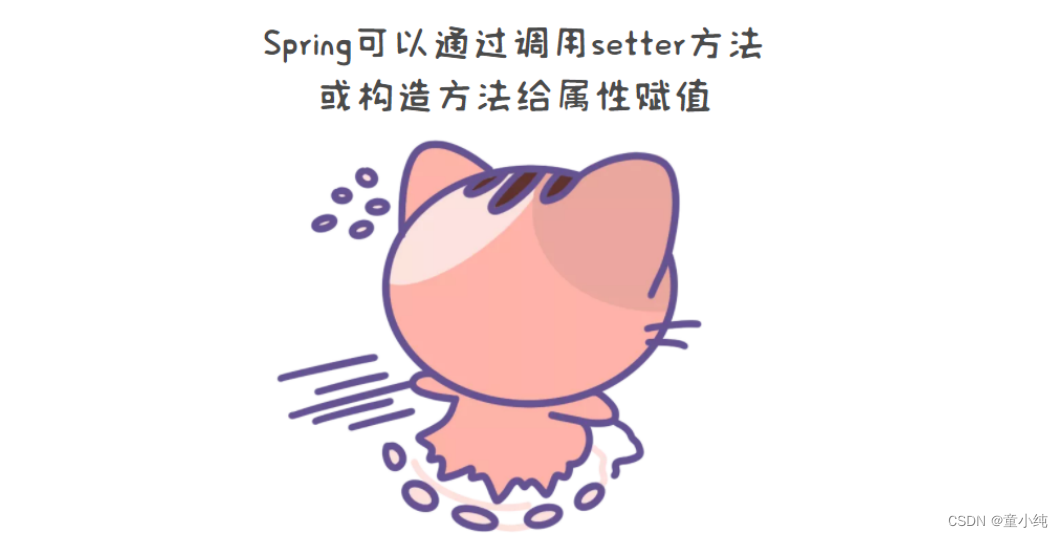
在之前开发中,可以通过setter方法或构造方法设置对象属性值:
// setter方法设置属性
StudentService studentService = new StudentService();
StudentDao studentDao = new StudentDao();
studentService.setStudentDao(studentDao);
// 构造方法设置属性
StudentDao studentDao = new StudentDao();
StudentService studentService = new StudentService(studentDao);Spring可以通过调用setter方法或构造方法给属性赋值
Setter注入
被注入类编写属性的setter方法
public class StudentService {private StudentDao studentDao;public void setStudentDao(StudentDao studentDao) {this.studentDao = studentDao;}
}
配置文件中,给需要注入属性值的<bean> 中设置<property>
<bean id="studentDao" class="com.itbaizhan.dao.StudentDaoImpl"></bean>
<bean id="studentService" class="com.itbaizhan.service.StudentService"><!--依赖注入--><!--name:对象的属性名 ref:容器中对象的id值--><property name="studentDao" ref="studentDao"></property>
</bean>测试是否注入成功
@Test
public void t2(){ApplicationContext ac = new ClassPathXmlApplicationContext("bean.xml");StudentService studentService = (StudentService) ac.getBean("studentService");System.out.println(studentService.findStudentById(1));
}构造方法注入
被注入类编写有参的构造方法
public class StudentService {private StudentDao studentDao;public StudentService(StudentDao studentDao) {this.studentDao = studentDao;}
}给需要注入属性值的<bean> 中设置<constructor-arg>
<bean id="studentDao" class="com.itbaizhan.dao.StudentDaoImpl"></bean>
<bean id="studentService" class="com.itbaizhan.service.StudentService"><!-- 依赖注入 --><!-- name:对象的属性名 ref:配置文件中注入对象的id值 --><constructor-arg name="studentDao" ref="studentDao"></constructor-arg>
</bean>
测试是否注入成功
@Test
public void t2(){ApplicationContext ac = new ClassPathXmlApplicationContext("bean.xml");StudentService studentService =(StudentService) ac.getBean("studentService");System.out.println(studentService.findStudentById(1));
}自动注入

自动注入不需要在 标签中添加其他标签注入属性值,而是自 动从容器中找到相应的bean对象设置为属性值。
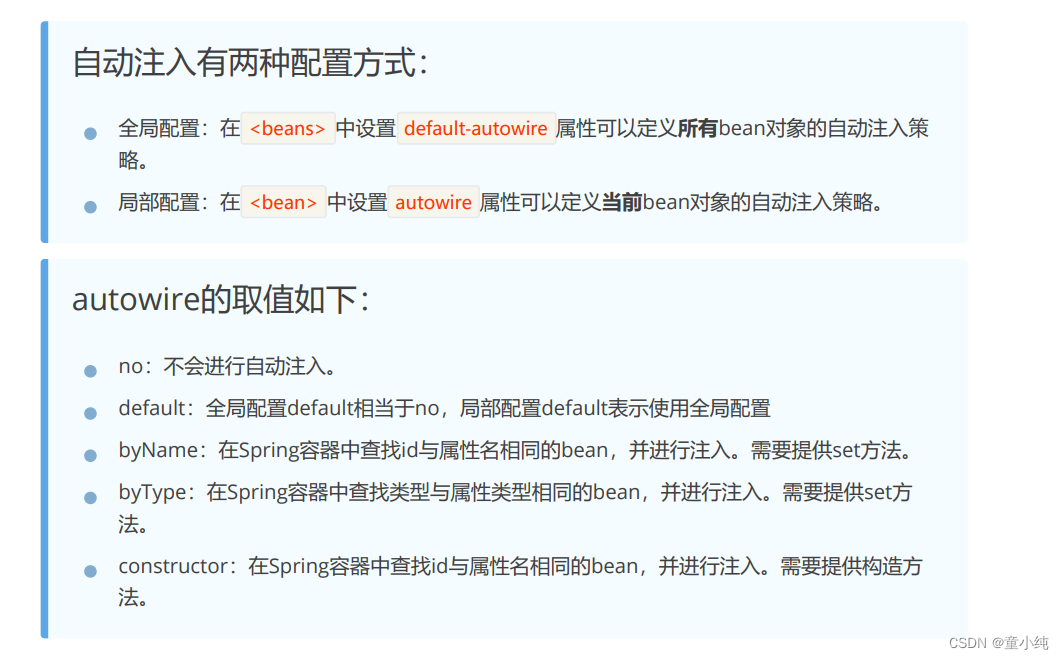
测试自动注入:
1、为依赖的对象提供setter和构造方法:
public class StudentService {// 依赖private StudentDao studentDao;// 构造方法public StudentService() { }public StudentService(StudentDao studentDao) {this.studentDao = studentDao;}// setter方法public void setStudentDao(StudentDao studentDao) {this.studentDao = studentDao;}// 调用依赖的方法public Student findStudentById(int id){return studentDao.findById(id);}
}2、配置自动注入:
<!-- 根据beanId等于属性名自动注入 -->
<bean id="studentDao" class="com.itbaizhan.dao.StudentDaoImpl"></bean>
<bean id="studentService" class="com.itbaizhan.service.StudentService" autowire="byName"></bean><!-- 根据bean类型等于属性类型自动注入 -->
<bean id="studentDao" class="com.itbaizhan.dao.StudentDaoImpl"></bean>
<bean id="studentService" class="com.itbaizhan.service.StudentService" autowire="byType"></bean><!-- 利用构造方法自动注入 -->
<bean id="studentDao" class="com.itbaizhan.dao.StudentDaoImpl"></bean>
<bean id="studentService" class="com.itbaizhan.service.StudentService" autowire="constructor"></bean><!-- 配置全局自动注入 -->
<beans xmlns="http://www.springframework.org/schema/beans"xmlns:xsi="http://www.w3.org/2001/XMLSchema-instance"xsi:schemaLocation="http://www.springframework.org/schema/beanshttp://www.springframework.org/schema/beans/spring-beans.xsd"default-autowire="constructor">DI_依赖注入类型

DI支持注入bean类型、基本数据类型和字符串、List集合、Set集合、Map集合、Properties对象类型等,他们的写法如下:
1、准备注入属性的类
public class StudentService {private StudentDao studentDao; // bean属性private String name; //字符串类型private int count; //基本数据类型private List<String> names; // 字符串类型List集合private List<Student> students1; // 对象类型List集合private Set<Student> students2; // 对象类型Set集合private Map<String,String> names2; //字符串类型Map集合private Map<String,Student> students3;// 对象类型Map集合private Properties properties;//Properties类型// 省略getter/setter/toString
}2、准备测试方法
@Test
public void t3(){ApplicationContext ac = newClassPathXmlApplicationContext("bean.xml");StudentService studentService =(StudentService)ac.getBean("studentService");System.out.println(studentService);
}
注入bean类型
写法一:
<bean id="studentDao" class="com.itbaizhan.dao.StudentDaoImpl"></bean>
<bean id="studentService" class="com.itbaizhan.service.StudentService"><property name="studentDao" ref="studentDao"></property>
</bean>写法二:
<bean id="studentDao" class="com.itbaizhan.dao.StudentDaoImpl"></bean>
<bean id="studentService" class="com.itbaizhan.service.StudentService"><property name="studentDao" ><ref bean="studentDao"></ref></property>
</bean>注入基本数据类型
<bean id="studentService" class="com.itbaizhan.service.StudentService"><!-- 写法一 name:属性名 value:属性值--><property name="name" value="百百">
</property><!-- 写法二 name:属性名 value:属性值--><property name="count"><value>10</value></property>
</bean>注入List集合
<bean id="studentService"
class="com.itbaizhan.service.StudentService"><!-- 简单数据类型List集合 name:属性名 --><property name="names"><list><value>强学堂</value><value>程序员</value></list></property><!-- 对象类型List集合 name:属性名 --><property name="students1"><list><bean class="com.itbaizhan.domain.Student"><property name="id" value="1"/><property name="name" value="强学堂"/><property name="address" value="北京"/></bean><bean class="com.itbaizhan.domain.Student"><property name="id" value="2"/><property name="name" value="百战不败"/><property name="address" value="北京"/></bean></list></property>
</bean>注入Set集合
<bean id="studentService" class="com.itbaizhan.service.StudentService"><!-- Set集合 --><property name="students2"><set><bean class="com.itbaizhan.domain.Student"><property name="id" value="1"/><property name="name" value="强学堂"/><property name="address" value="北京"/></bean><bean class="com.itbaizhan.domain.Student"><property name="id" value="2"/><property name="name" value="百战不败"/><property name="address" value="北京"/></bean></set></property>
</bean>注入Map集合
简单数据类型Map集合:
<bean id="studentService" class="com.itbaizhan.service.StudentService"><property name="names2"><map><entry key="student1" value="bz"/><entry key="student2" value="sxt"/></map></property>
</bean>对象类型Map集合:
<bean id="studentService" class="com.itbaizhan.service.StudentService"><property name="students3"><map><entry key="student1" value-ref="s1"/><entry key="student2" value-ref="s2"/></map></property>
</bean>
<bean id="s1" class="com.itbaizhan.domain.Student"><property name="id" value="1"/><property name="name" value="强学堂"/><property name="address" value="北京"/>
</bean>
<bean id="s2" class="com.itbaizhan.domain.Student"><property name="id" value="2"/><property name="name" value="百战不败"/><property name="address" value="北京"/>
</bean>注入Properties对象
<bean id="studentService" class="com.itbaizhan.service.StudentService"><property name="properties"><props><prop key="配置1">值1</prop><prop key="配置2">值2</prop></props></property>
</bean>注解实现IOC_准备工作
注解配置和xml配置对于Spring的IOC要实现的功能都是一样的,只是配置的形式不一样。
准备工作
1 创建一个新的Spring项目。
2 编写pojo,dao,service类。
3 编写空的配置文件,如果想让该文件支持注解,需要添加新的约束:
<?xml version="1.0" encoding="UTF-8"?>
<beans xmlns="http://www.springframework.org/schema/beans"xmlns:context="http://www.springframework.org/schema/context"xmlns:xsi="http://www.w3.org/2001/XMLSchema-instance"xsi:schemaLocation="http://www.springframework.org/schema/beanshttp://www.springframework.org/schema/beans/spring-beans.xsdhttp://www.springframework.org/schema/contexthttp://www.springframework.org/schema/context/spring-context.xsd">
</beans>注解实现IOC_@Component

作用:用于创建对象,放入Spring容器,相当于
位置:类上方
注意:
1、要在配置文件中配置扫描的包,扫描到该注解才能生效。
<context:component-scan base-package="com.itbaizhan"></context:component-scan>2、@Component 注解配置bean的默认id是首字母小写的类名。也 可以手动设置bean的id值。
// 此时bean的id为studentDaoImpl @Component public class StudentDaoImpl implements StudentDao{public Student findById(int id) {// 模拟根据id查询学生return new Student(1,"程序员","北京");} } // 此时bean的id为studentDao @Component("studentDao") public class StudentDaoImpl implements StudentDao{public Student findById(int id) {// 模拟根据id查询学生return new Student(1,"程序员","北京");} }
注解实现IOC_@Repository、@Service、@Controller
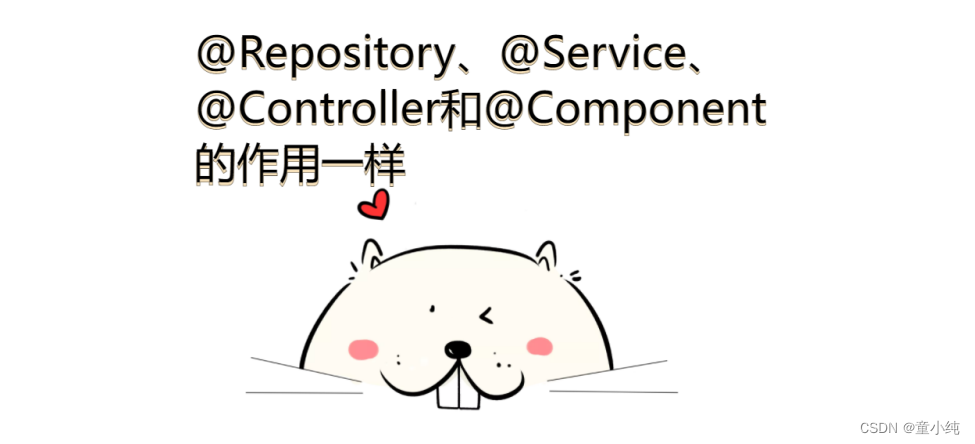
作用:这三个注解和@Component的作用一样,使用它们是为了区 分该类属于什么层。
位置:
1、@Repository用于Dao层
2、@Service用于Service层
3、@Controller用于Controller层
@Repository
public class StudentDaoImpl implements StudentDao{}
@Service
public class StudentService {}注解实现IOC_@Scope

作用:指定bean的创建策略
位置:类上方
取值:singleton prototype request session globalsession
@Service @Scope("singleton") public class StudentService {}
注解实现IOC_@Autowired

作用:从容器中查找符合属性类型的对象自动注入属性中。用于代替<bean> 中的依赖注入配置。
位置:属性上方、setter方法上方、构造方法上方。
注意:
1、@Autowired 写在属性上方进行依赖注入时,可以省略setter方法。
@Component public class StudentService {@Autowiredprivate StudentDao studentDao;public Student findStudentById(int id){return studentDao.findById(id);} } @Test public void t2(){ApplicationContext ac = new ClassPathXmlApplicationContext("bean.xml");StudentService studentService =(StudentService)ac.getBean("studentService");System.out.println(studentService.findStudentById(1)); }2、容器中没有对应类型的对象会报错
// 如果StudentDaoImpl没有放到容器中会报错 //@Component("studentDao") public class StudentDaoImpl implements StudentDao{public Student findById(int id) {// 模拟根据id查询学生return new Student(1,"程序员","北京");} }3 、容器中有多个对象匹配类型时,会找beanId等于属性名的对 象,找不到会报错。
// 如果容器中都多个同类型对象,会根据id值等于属性 名找对象 @Component("studentDao") public class StudentDaoImpl implements StudentDao{public Student findById(int id) {// 模拟根据id查询学生return new Student(1,"程序员","北京");} } @Component public class StudentDaoImpl implements StudentDao{public Student findById(int id) {// 模拟根据id查询学生return new Student(1,"程序员","北京");} }
注解实现IOC_@Qualifier
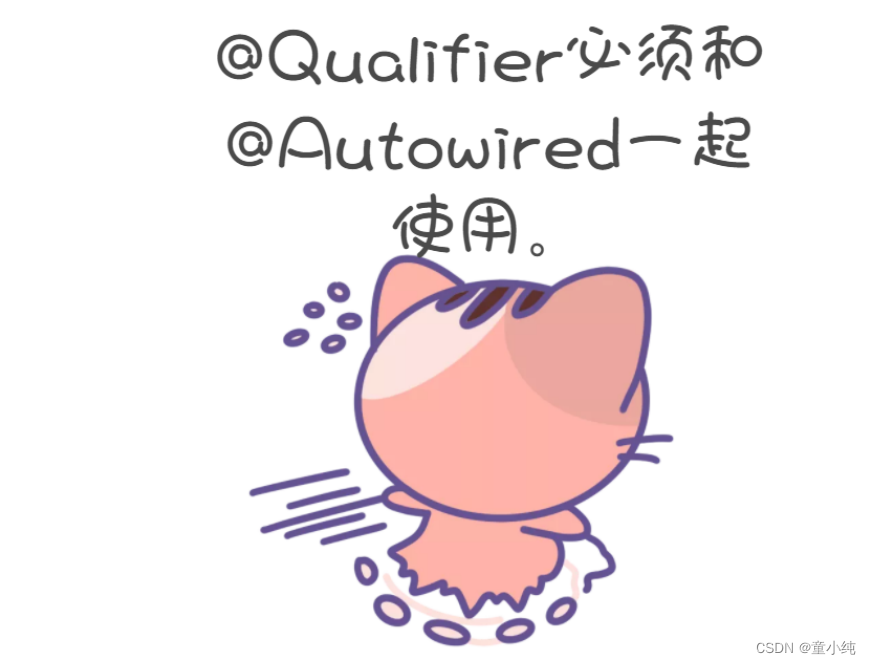
作用:在按照类型注入对象的基础上,再按照bean的id注入。
位置:属性上方
注意:@Qualifier必须和@Autowired一起使用。
@Component
public class StudentService {@Autowired@Qualifier("studentDaoImpl2")private StudentDao studentDao;public Student findStudentById(int id){return studentDao.findById(id);}
}注解实现IOC_@Value

作用:注入String类型和基本数据类型的属性值。
位置:属性上方
用法:
1 、直接设置固定的属性值
@Service public class StudentService {@Value("1")private int count;@Value("hello")private String str; }2 、获取配置文件中的属性值:
2.1 、编写配置文件db.properties
jdbc.username=root jdbc.password01=1234562.2、spring核心配置文件扫描配置文件
<context:property-placeholder location="db.properties"> </context:property-placeholder>2.3 注入配置文件中的属性值
@Value("${jdbc.username}") private String username; @Value("${jdbc.password}") private String password;
注解实现IOC_@Configuration

此时基于注解的IOC配置已经完成,但是我们依然离不开Spring的 xml配置文件。接下来我们脱离bean.xml,使用纯注解实现IOC。
在真实开发中,我们一般还是会保留xml配置文件,很多情况下使用配置文件更加方便。
纯注解实现IOC需要一个Java类代替xml文件。这个Java类上方需要 添加@Configuration,表示该类是一个配置类,作用是代替配置文件。
@Configuration
public class SpringConfig {
}注解实现IOC_@ComponentScan
作用:指定spring在初始化容器时扫描的包。
位置:配置类上方
@Configuration @ComponentScan("com.itbaizhan")public class SpringConfig { }
注解实现IOC_@PropertySource

作用:代替配置文件中的<context:property-placeholder> 扫描配置文件
位置:配置类上方
注意:配置文件位置前要加关键字 classpath
@Configuration
@PropertySource("classpath:db.properties")
public class JdbcConfig {@Value("${jdbc.username}")private String username;@Value("${jdbc.password}")private String password;
}注解实现IOC_@Bean

作用:将方法的返回值对象放入Spring容器中。如果想将第三方类 的对象放入容器,可以使用@Bean
位置:配置类的方法上方。
属性:name:给bean对象设置id
注意:@Bean修饰的方法如果有参数,spring会根据参数类型从容 器中查找可用对象。
举例:如果想将jdbc连接对象放入Spring容器,我们无法修改 Connection源码添加@Component,此时就需要使用将@Bean该 对象放入Spring容器
1 、添加驱动依赖
<dependency><groupId>mysql</groupId><artifactId>mysql-connector-java</artifactId><version>8.0.27</version> </dependency>2、将Connection对象放入Spring容器
@Bean(name = "connection") public Connection getConnection(){try {Class.forName("com.mysql.cj.jdbc.Driver");returnDriverManager.getConnection("jdbc:mysql:///mysql", "root", "root");} catch (Exception exception) {return null;} }3、测试
@Test public void t5(){ApplicationContext ac = new AnnotationConfigApplicationContext(SpringConfig.class);Connection connection = (Connection)ac.getBean("connection");System.out.println(connection); }
注解实现IOC_@Import

作用:如果配置过多,会有多个配置类,该注解可以为主配置类导入其他配置类
位置:主配置类上方
// Jdbc配置类
@Configuration
public class JdbcConfig {@Bean(name = "connection")public Connection getConnection(){try {Class.forName("com.mysql.cj.jdbc.Driver");return DriverManager.getConnection("jdbc:mysql:///mysql", "root", "root");} catch (Exception exception) {return null;}}
}
// 主配置类
@Configuration
@ComponentScan("com.itbaizhan")
@Import(JdbcConfig.class)
public class SpringConfig { }Spring整合MyBatis_搭建环境
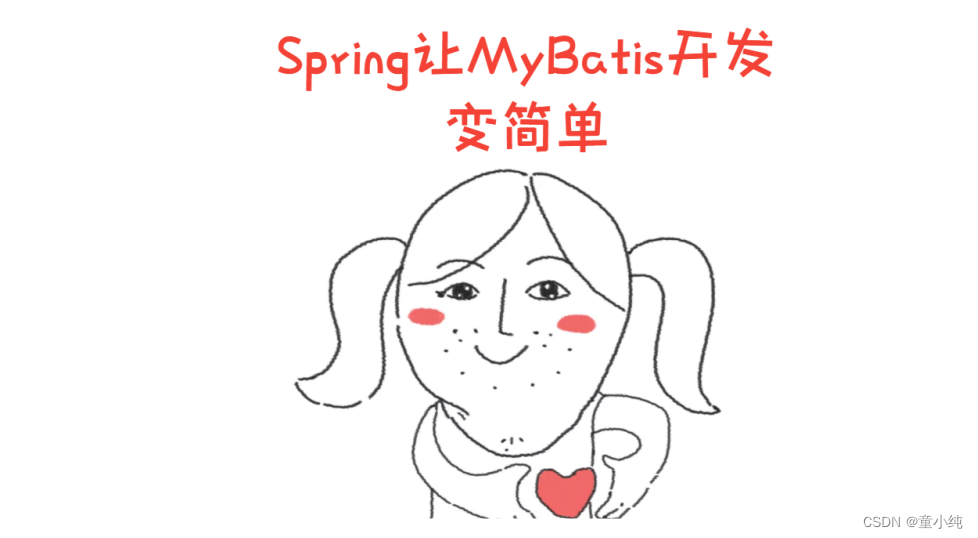
我们知道使用MyBatis时需要写大量创建 SqlSessionFactoryBuilder、SqlSessionFactory、SqlSession等对 象的代码,而Spring的作用是帮助我们创建和管理对象,所以我们 可以使用Spring整合MyBatis,简化MyBatis开发。
创建maven项目,引入依赖。
<dependencies><!-- mybatis --><dependency><groupId>org.mybatis</groupId><artifactId>mybatis</artifactId><version>3.5.7</version></dependency><!-- mysql驱动包 --><dependency><groupId>mysql</groupId><artifactId>mysql-connector-java</artifactId><version>8.0.26</version></dependency><!-- spring --><dependency><groupId>org.springframework</groupId><artifactId>spring-context</artifactId><version>5.3.13</version></dependency><dependency><groupId>org.springframework</groupId><artifactId>spring-tx</artifactId><version>5.3.13</version></dependency><dependency><groupId>org.springframework</groupId><artifactId>spring-jdbc</artifactId><version>5.3.13</version></dependency><!-- MyBatis与Spring的整合包,该包可以让Spring创建MyBatis的对象 --><dependency><groupId>org.mybatis</groupId><artifactId>mybatis-spring</artifactId><version>2.0.6</version></dependency>
</dependencies>
Spring整合MyBatis_编写配置文件
1、编写数据库配置文件db.properties
jdbc.driverClassName = com.mysql.jdbc.Driver
jdbc.url = jdbc:mysql:///student
jdbc.username = root
jdbc.password01 = root2、创建MyBatis配置文件SqlMapConfig.xml,数据源、扫描接口都 交由Spring管理,不需要在MyBatis配置文件中设置。
<?xml version="1.0" encoding="UTF-8"?>
<!DOCTYPE configurationPUBLIC "-//mybatis.org//DTD Config3.0//EN""http://mybatis.org/dtd/mybatis-3-config.dtd">
<configuration>
</configuration>3、创建Spring配置文件applicationContext.xml
<?xml version="1.0" encoding="UTF-8"?>
<beans xmlns="http://www.springframework.org/schema/beans"xmlns:context="http://www.springframework.org/schema/context"xmlns:xsi="http://www.w3.org/2001/XMLSchema-instance"xsi:schemaLocation="http://www.springframework.org/schema/beanshttp://www.springframework.org/schema/beans/spring-beans.xsdhttp://www.springframework.org/schema/contexthttp://www.springframework.org/schema/context/spring-context.xsd"><!-- 包扫描 --><context:component-scan base-package="com.itbaizhan"></context:component-scan><!-- 读取配置文件 --><context:property-placeholder location="classpath:db.properties"></context:property-placeholder><!-- 创建druid数据源对象 --><bean id="dataSource" class="com.alibaba.druid.pool.DruidDataSource"><property name="driverClassName" value="${jdbc.driverClassName}"></property><property name="url" value="${jdbc.url}"></property><property name="username" value="${jdbc.username}"></property><property name="password" value="${jdbc.password}"></property></bean><!-- Spring创建封装过的SqlSessionFactory--><bean id="sqlSessionFactory" class="org.mybatis.spring.SqlSessionFactoryBean"><property name="dataSource" ref="dataSource"></property></bean><!-- Spring创建封装过的SqlSession --><bean id="sqlSession" class="org.mybatis.spring.SqlSessionTemplate"><constructor-arg name="sqlSessionFactory" ref="sqlSessionFactory"/></bean>
</beans>Spring整合MyBatis_准备数据库和实体类
准备数据库
CREATE DATABASE `student`;
USE `student`;
DROP TABLE IF EXISTS `student`;
CREATE TABLE `student` (`id` int(11) NOT NULL AUTO_INCREMENT,`name` varchar(255) DEFAULT NULL,`sex` varchar(10) DEFAULT NULL,`address` varchar(255) DEFAULT NULL,PRIMARY KEY (`id`)
) ENGINE=InnoDB AUTO_INCREMENT=3 DEFAULT
CHARSET=utf8;
insert into
`student`(`id`,`name`,`sex`,`address`)
values (1,'程序员','男','北京'),(2,'北京学堂','女','北京');
准备实体类
public class Student {private int id;private String name;private String sex;private String address;// 省略构造方法/getter/setter/tostring
}Spring整合MyBatis_编写持久层接口和service类
编写持久层接口
@Repository
public interface StudentDao {// 查询所有学生@Select("select * from student")List<Student> findAll();// 添加学生@Insert("insert into student values(null,#{name},#{sex},#{address})")void add(Student student);
}编写service类
@Service
public class StudentService {// SqlSession对象@Autowiredprivate SqlSessionTemplate sqlSession;// 使用SqlSession获取代理对象public List<Student> findAllStudent(){StudentDao studentDao = sqlSession.getMapper(StudentDao.class);return studentDao.findAll();}
}Spring整合MyBatis_Spring整合Junit进行单元测试
之前进行单元测试时都需要手动创建Spring容器,能否在测试时让 Spring自动创建容器呢?
1 、引入Junit和Spring整合Junit依赖
<!-- junit,如果Spring5整合junit,则junit版本
至少在4.12以上 -->
<dependency><groupId>junit</groupId><artifactId>junit</artifactId><version>4.12</version><scope>test</scope>
</dependency>
<!-- spring整合测试模块 -->
<dependency><groupId>org.springframework</groupId><artifactId>spring-test</artifactId><version>5.3.13</version>
</dependency>2 、编写测试类
// JUnit使用Spring方式运行代码,即自动创建spring容器。
@RunWith(SpringJUnit4ClassRunner.class)
// 告知创建spring容器时读取哪个配置类或配置文件
// 配置类写法:
@ContextConfiguration(classes=配置类.class)
@ContextConfiguration(locations="classpath:applicationContext.xml")
public class StudentServiceTest {@Autowiredprivate StudentService studentService;@Testpublic void testFindAll(){List<Student> allStudent = studentService.findAllStudent();allStudent.forEach(System.out::println);}
}注:使用SqlSessionTemplate创建代理对象还是需要注册接口 或者映射文件的。
1、在MyBatis配置文件注册接口
<configuration><mappers><mapper class="com.itbaizhan.dao.StudentDao"></mapper></mappers> </configuration>2、创建sqlSessionFactory时指定MyBatis配置文件
<!-- 创建Spring封装过的SqlSessionFactory --> <bean id="sqlSessionFactory" class="org.mybatis.spring.SqlSessionFactoryBean"><property name="dataSource" ref="dataSource"></property><property name="configLocation" value="classpath:SqlMapConfig.xml"></property> </bean>
Spring整合MyBatis_自动创建代理对象
Spring提供了MapperScannerConfigurer对象,该对象可以自动扫 描包创建代理对象,并将代理对象放入容器中,此时不需要使用 SqlSession手动创建代理对象。
1、创建MapperScannerConfigurer对象
<!-- 该对象可以自动扫描持久层接口,并为接口创建代理对象 --> <bean id="mapperScanner" class="org.mybatis.spring.mapper.MapperScannerConfigurer"><!-- 配置扫描的接口包 --><property name="basePackage" value="com.itbaizhan.dao"></property> </bean>2、Service类直接使用代理对象即可
@Service public class StudentService {// 直接注入代理对象@Autowiredprivate StudentDao studentDao;// 直接使用代理对象public void addStudent(Student student){studentDao.add(student);} }3、测试
@RunWith(SpringJUnit4ClassRunner.class) @ContextConfiguration(locations="classpath :applicationContext.xml") public class StudentServiceTest {@Autowiredprivate StudentService studentService;@Testpublic void testAdd(){Student student = new Student(0, "百战不败", "男", "上海");studentService.addStudent(student);} }
SpringAOP_AOP简介
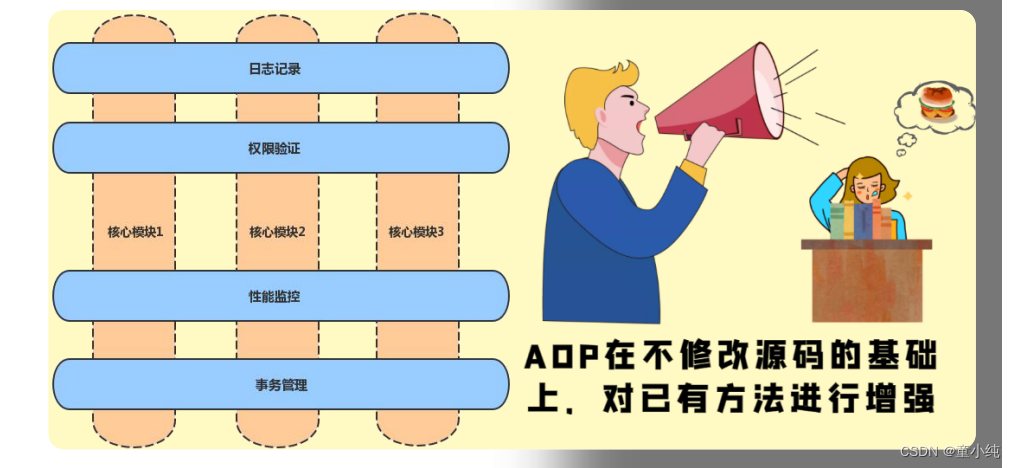
AOP的全称是Aspect Oriented Programming,即面向切面编程。 是实现功能统一维护的一种技术,它将业务逻辑的各个部分进行隔 离,使开发人员在编写业务逻辑时可以专心于核心业务,从而提高 了开发效率。
作用:在不修改源码的基础上,对已有方法进行增强。
实现原理:动态代理技术。
优势:减少重复代码、提高开发效率、维护方便
应用场景:事务处理、日志管理、权限控制、异常处理等方面。
SpringAOP_AOP相关术语
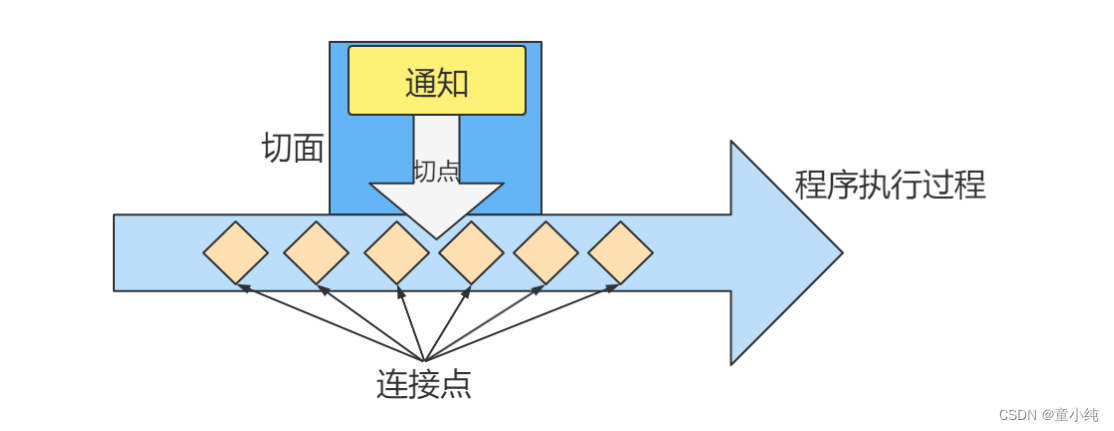
为了更好地理解AOP,就需要对AOP的相关术语有一些了解
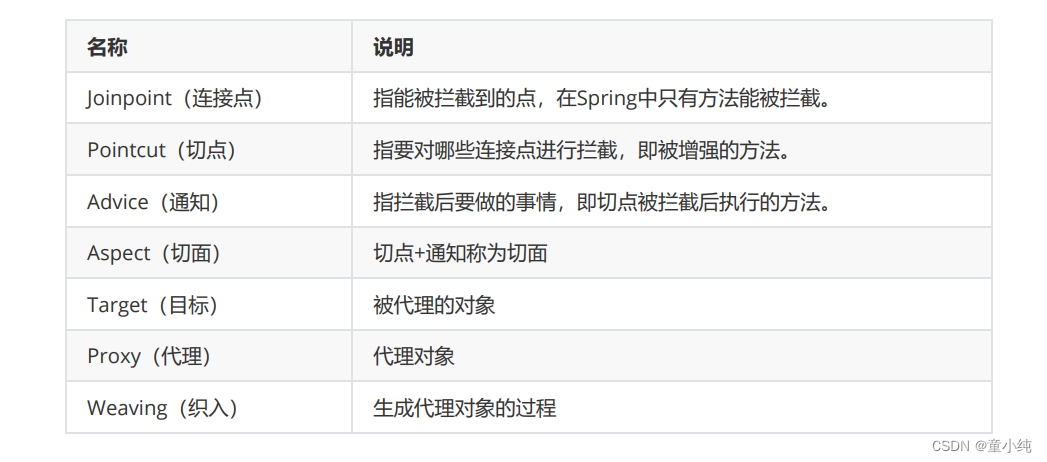
SpringAOP_AOP入门
AspectJ是一个基于Java语言的AOP框架,在Spring框架中建议使用 AspectJ实现AOP。
接下来我们写一个AOP入门案例:dao层的每个方法结束后都可以 打印一条日志:
1、引入依赖
<!-- spring --> <dependency><groupId>org.springframework</groupId><artifactId>spring-context</artifactId><version>5.3.13</version> </dependency><!-- AspectJ --> <dependency><groupId>org.aspectj</groupId><artifactId>aspectjweaver</artifactId><version>1.8.7</version> </dependency><!-- junit --> <dependency><groupId>junit</groupId><artifactId>junit</artifactId><version>4.12</version><scope>test</scope> </dependency>2、编写连接点
@Repository public class UserDao {public void add(){System.out.println("用户新增");}public void delete(){System.out.println("用户删除");}public void update(){System.out.println("用户修改");} }3、编写通知类
public class MyAspectJAdvice {// 后置通知public void myAfterReturning() {System.out.println("打印日志...");} }4、配置切面
<?xml version="1.0" encoding="UTF-8"?> <beans xmlns="http://www.springframework.org/schema/beans"xmlns:context="http://www.springframework.org/schema/context"xmlns:aop="http://www.springframework.org/schema/aop"xmlns:xsi="http://www.w3.org/2001/XMLSchema-instance"xsi:schemaLocation="http://www.springframework.org/schema/beanshttp://www.springframework.org/schema/beans/spring-beans.xsdhttp://www.springframework.org/schema/contexthttp://www.springframework.org/schema/context/spring-context.xsdhttp://www.springframework.org/schema/aophttp://www.springframework.org/schema/aop/spring-aop.xsd"><context:component-scan base-package="com.itbaizhan"></context:component-scan><!-- 通知对象 --><bean id="myAspectJAdvice" class="com.itbaizhan.advice.MyAspectAdvice"></bean><!-- 配置AOP --><aop:config><!-- 配置切面 --><aop:aspect ref="myAspectJAdvice"><!-- 配置切点 --><aop:pointcut id="myPointcut" expression="execution(* com.itbaizhan.dao.UserDao.*(..))"/><!-- 配置通知 --><aop:after-returning method="myAfterReturning" pointcutref="myPointcut"/></aop:aspect></aop:config> </beans>5、测试
public class UserDaoTest {@Testpublic void testAdd(){ApplicationContext ac = new ClassPathXmlApplicationContext("bean.xml");UserDao userDao = (UserDao) ac.getBean("userDao");userDao.add();}@Testpublic void testDelete(){ApplicationContext ac = new ClassPathXmlApplicationContext("bean.xml");UserDao userDao = (UserDao)ac.getBean("userDao");userDao.delete();}@Testpublic void testUpdate(){ApplicationContext ac = new ClassPathXmlApplicationContext("bean.xml");UserDao userDao = (UserDao) ac.getBean("userDao");userDao.update();} }
SpringAOP_通知类型

AOP有以下几种常用的通知类型:

1、编写通知方法
// 通知类 public class MyAspectAdvice {// 后置通知public void myAfterReturning(JoinPoint joinPoint) {System.out.println("切点方法名:" + joinPoint.getSignature().getName());System.out.println("目标对象:" + joinPoint.getTarget());System.out.println("打印日志" + joinPoint.getSignature().getName() + "方法被执行了!");}// 前置通知public void myBefore() {System.out.println("前置通知...");}// 异常通知public void myAfterThrowing(Exception ex) {System.out.println("异常通知...");System.err.println(ex.getMessage());}// 最终通知public void myAfter() {System.out.println("最终通知");}// 环绕通知public Object myAround(ProceedingJoinPoint proceedingJoinPoint) throws Throwable {System.out.println("环绕前");Object obj = proceedingJoinPoint.proceed(); // 执行方法System.out.println("环绕后");return obj;} }2、配置切面
<!-- 配置AOP --> <aop:config><!-- 配置切面 --><aop:aspect ref="myAspectJAdvice"><!-- 配置切点 --><aop:pointcut id="myPointcut" expression="execution(* com.itbaizhan.dao.UserDao.*(..))"/><!-- 前置通知 --><aop:before method="myBefore" pointcut-ref="myPointcut"></aop:before><!-- 后置通知 --><aop:after-returning method="myAfterReturning" pointcutref="myPointcut"/><!-- 异常通知 --><aop:after-throwing method="myAfterThrowing" pointcutref="myPointcut" throwing="ex"/><!-- 最终通知 --><aop:after method="myAfter" pointcut-ref="myPointcut"></aop:after><!-- 环绕通知 --><aop:around method="myAround" pointcut-ref="myPointcut"></aop:around></aop:aspect> </aop:config>
SpringAOP_切点表达式
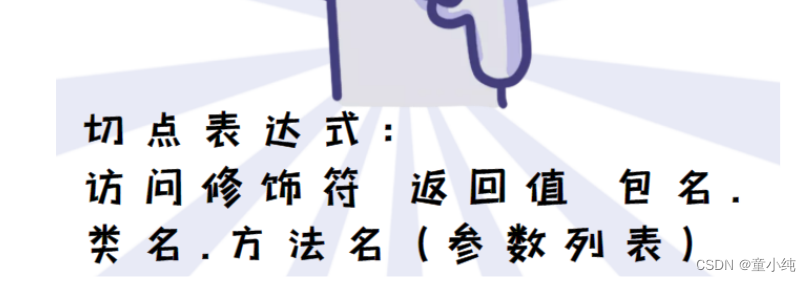
使用AspectJ需要使用切点表达式配置切点位置,写法如下:
1、标准写法:访问修饰符 返回值 包名.类名.方法名(参数列表)
2、访问修饰符可以省略。
3、返回值使用 * 代表任意类型。
4、包名使用 * 表示任意包,多级包结构要写多个 * ,使用 *.. 表示任 意包结构
5、类名和方法名都可以用 * 实现通配。
6、参数列表
基本数据类型直接写类型 引用类型写 包名.类名 * 表示匹配一个任意类型参数 .. 表示匹配任意类型任意个数的参数7、全通配: * *..*.*(..)
SpringAOP_多切面配置
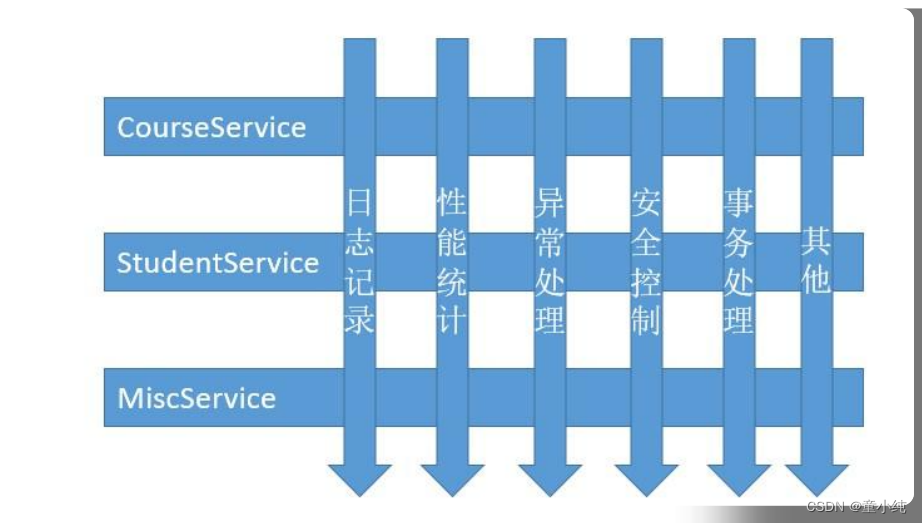
我们可以为切点配置多个通知,形成多切面,比如希望dao层的每 个方法结束后都可以打印日志并发送邮件:
1、编写发送邮件的通知:
public class MyAspectJAdvice2 {// 后置通知public void myAfterReturning(JoinPoint joinPoint) {System.out.println("发送邮件");} }2、配置切面:
<!-- 通知对象 --> <bean id="myAspectJAdvice" class="com.itbaizhan.advice.MyAspectAdvice"></bean> <bean id="myAspectJAdvice2" class="com.itbaizhan.advice.MyAspectAdvice2"></bean> <!-- 配置AOP --> <aop:config><!-- 配置切面 --><aop:aspect ref="myAspectJAdvice"><!-- 配置切点 --><aop:pointcut id="myPointcut" expression="execution(* *..*.*(..))"/><!-- 后置通知 --><aop:after-returning method="myAfterReturning" pointcutref="myPointcut"/></aop:aspect><aop:aspect ref="myAspectJAdvice2"><aop:pointcut id="myPointcut2" expression="execution(*com.itbaizhan.dao.UserDao.*(..))"/><aop:after-returning method="myAfterReturning" pointcut-ref="myPointcut2"/></aop:aspect> </aop:config>
SpringAOP_注解配置AOP
Spring可以使用注解代替配置文件配置切面:
1、在xml中开启AOP注解支持
<!-- 开启注解配置Aop --> <aop:aspectj-autoproxy></aop:aspectj-autoproxy>2、在通知类上方加入注解 @Aspect
3、在通知方法上方加入注解
@Before/@AfterReturning/@AfterThrowing/@After/@Around@Aspect @Component public class MyAspectAdvice {// 后置通知@AfterReturning("execution(* com.itbaizhan.dao.UserDao.*(..))")public void myAfterReturning(JoinPoint joinPoint) {System.out.println("切点方法名:" + joinPoint.getSignature().getName());System.out.println("目标对象:" + joinPoint.getTarget());System.out.println("打印日志" + joinPoint.getSignature().getName() + "方法被执行了!");}// 前置通知@Before("execution(* com.itbaizhan.dao.UserDao.*(..))")public void myBefore() {System.out.println("前置通知...");}// 异常通知@AfterThrowing(value = "execution(* com.itbaizhan.dao.UserDao.*(..))",throwing = "ex")public void myAfterThrowing(Exception ex) {System.out.println("异常通知...");System.err.println(ex.getMessage());}// 最终通知@After("execution(* com.itbaizhan.dao.UserDao.*(..))")public void myAfter() {System.out.println("最终通知");}// 环绕通知@Around("execution(* com.itbaizhan.dao.UserDao.*(..))")public Object myAround(ProceedingJoinPoint proceedingJoinPoint) throws Throwable {System.out.println("环绕前");Object obj = proceedingJoinPoint.proceed(); // 执行方法System.out.println("环绕后");return obj;} }
4、测试:
@Test public void testAdd2(){ApplicationContext ac = new ClassPathXmlApplicationContext("bean1.xml");UserDao userDao = (UserDao) ac.getBean("userDao");userDao.update(); }
如何为一个类下的所有方法统一配置切点:
1、在通知类中添加方法配置切点
@Pointcut("execution(* com.itbaizhan.dao.UserDao.*(..))") public void pointCut(){}2、在通知方法上使用定义好的切点
@Before("pointCut()") public void myBefore(JoinPoint joinPoint) {System.out.println("前置通知..."); } @AfterReturning("pointCut()") public void myAfterReturning(JoinPoint joinPoint) {System.out.println("后置通知..."); }配置类如何代替xml中AOP注解支持?
在配置类上方添加@EnableAspectJAutoProxy即可
@Configuration @ComponentScan("com.itbaizhan") @EnableAspectJAutoProxy public class SpringConfig { }
SpringAOP_原生Spring实现AOP

除了AspectJ,Spring支持原生方式实现AOP。
1、引入依赖
<!-- AOP --> <dependency><groupId>org.springframework</groupId><artifactId>spring-aop</artifactId><version>5.3.13</version> </dependency>2、编写通知类
// Spring原生Aop的通知类 public class SpringAop implements MethodBeforeAdvice, AfterReturningAdvice, ThrowsAdvice, MethodInterceptor {/*** 前置通知* @param method 目标方法* @param args 目标方法的参数列表* @param target 目标对象* @throws Throwable*/@Overridepublic void before(Method method, Object[] args, Object target) throws Throwable {System.out.println("前置通知");}/*** 后置通知* @param returnValue 目标方法的返回值* @param method 目标方法* @param args 目标方法的参数列表* @param target 目标对象* @throws Throwable*/@Overridepublic void afterReturning(Object returnValue, Method method, Object[] args, Object target) throws Throwable {System.out.println("后置通知");}/*** 环绕通知* @param invocation 目标方法* @return* @throws Throwable*/@Overridepublic Object invoke(MethodInvocation invocation) throws Throwable {System.out.println("环绕前");Object proceed = invocation.proceed();System.out.println("环绕后");return proceed;}/*** 异常通知* @param ex 异常对象*/public void afterThrowing(Exception ex){System.out.println("发生异常了!");} }Spring原生方式实现AOP时,只支持四种通知类型:
3、编写配置类
<!-- 通知对象 --> <bean id="springAop" class="com.itbaizhan.advice.SpringAop"></bean> <!-- 配置代理对象 --> <bean id="userDaoProxy" class="org.springframework.aop.framework.ProxyFactoryBean"><!-- 配置目标对象 --><property name="target" ref="userDao"></property><!-- 配置通知 --><property name="interceptorNames"><list><value>springAop</value></list></property><!-- 代理对象的生成方式 true:使用CGLib false:使用原生JDK生成--><property name="proxyTargetClass" value="true"></property> </bean>4、编写测试类
public class UserDaoTest2 {@Testpublic void testAdd(){ApplicationContext ac = new ClassPathXmlApplicationContext("bean2.xml");UserDao userDao = (UserDao) ac.getBean("userDaoProxy"); // 获取的是代理对象userDao.update();} }
SpringAOP_SchemaBased实现AOP
SchemaBased(基础模式)配置方式是指使用Spring原生方式定义通 知,而使用AspectJ框架配置切面。
1、编写通知类
public class SpringAop implements MethodBeforeAdvice, AfterReturningAdvice,ThrowsAdvice, MethodInterceptor {/*** 前置通知* @param method 目标方法* @param args 目标方法的参数列表* @param target 目标对象* @throws Throwable*/@Overridepublic void before(Method method, Object[] args, Object target) throws Throwable {System.out.println("前置通知");}/*** 后置通知* @param returnValue 目标方法的返回值* @param method 目标方法* @param args 目标方法的参数列表* @param target 目标对象* @throws Throwable*/@Overridepublic void afterReturning(Object returnValue, Method method, Object[] args, Object target) throws Throwable {System.out.println("后置通知");}/*** 环绕通知* @param invocation 目标方法* @return* @throws Throwable*/@Overridepublic Object invoke(MethodInvocation invocation) throws Throwable {System.out.println("环绕前");Object proceed = invocation.proceed();System.out.println("环绕后");return proceed;}/*** 异常通知* @param ex 异常对象*/public void afterThrowing(Exception ex){System.out.println("发生异常了!");} }2、配置切面
<!-- 通知对象 --> <bean id="springAop2" class="com.itbaizhan.aop.SpringAop2"/> <!-- 配置切面 --> <aop:config><!-- 配置切点--><aop:pointcut id="myPointcut" expression="execution(* com.itbaizhan.dao.UserDao.*(..))"/><!-- 配置切面:advice-ref:通知对象 pointcut-ref:切点 --><aop:advisor advice-ref="springAop2" pointcut-ref="myPointcut"/> </aop:config>3、测试
@Test public void t6(){ApplicationContext ac = new ClassPathXmlApplicationContext("aop3.xml");UserDao userDao = (UserDao) ac.getBean("userDao");userDao.add(); }
Spring事务_事务简介
事务:不可分割的原子操作。即一系列的操作要么同时成功,要么同时失败。
开发过程中,事务管理一般在service层,service层中可能会操作多次数据库,这些操作是不可分割的。否则当程序报错时,可能会造 成数据异常。
如:张三给李四转账时,需要两次操作数据库:张三存款减少、李四存款增加。如果这两次数据库操作间出现异常,则会造成数据错 误。
1、准备数据库
CREATE DATABASE `spring` ; USE `spring`; DROP TABLE IF EXISTS `account`; CREATE TABLE `account` (`id` int(11) NOT NULL AUTO_INCREMENT,`username` varchar(255) DEFAULT NULL,`balance` double DEFAULT NULL,PRIMARY KEY (`id`) ) ENGINE=InnoDB AUTO_INCREMENT=3 DEFAULT CHARSET=utf8; insert into `account`(`id`,`username`,`balance`) values (1,'张三',1000),(2,'李四',1000);2、创建maven项目,引入依赖
<dependencies><!-- mybatis --><dependency><groupId>org.mybatis</groupId><artifactId>mybatis</artifactId><version>3.5.7</version></dependency><!-- mysql驱动包 --><dependency><groupId>mysql</groupId><artifactId>mysql-connectorjava</artifactId><version>8.0.26</version></dependency><!-- druid连接池 --><dependency><groupId>com.alibaba</groupId><artifactId>druid</artifactId><version>1.2.8</version></dependency><!-- spring --><dependency><groupId>org.springframework</groupId><artifactId>springcontext</artifactId><version>5.3.13</version></dependency><dependency><groupId>org.springframework</groupId><artifactId>spring-tx</artifactId><version>5.3.13</version></dependency><dependency><groupId>org.springframework</groupId><artifactId>springjdbc</artifactId><version>5.3.13</version></dependency><!-- MyBatis与Spring的整合包,该包可以让Spring创建MyBatis的对象 --><dependency><groupId>org.mybatis</groupId><artifactId>mybatisspring</artifactId><version>2.0.6</version></dependency><!-- junit,如果Spring5整合junit,则junit版本至少在4.12以上 --><dependency><groupId>junit</groupId><artifactId>junit</artifactId><version>4.12</version><scope>test</scope></dependency><!-- spring整合测试模块 --><dependency><groupId>org.springframework</groupId><artifactId>springtest</artifactId><version>5.3.13</version><scope>test</scope></dependency> </dependencies>3、创建配置文件
<?xml version="1.0" encoding="UTF-8"?> <beans xmlns="http://www.springframework.org/schema/beans"xmlns:context="http://www.springframework.org/schema/context"xmlns:xsi="http://www.w3.org/2001/XMLSchema-instance"xsi:schemaLocation="http://www.springframework.org/schema/beanshttp://www.springframework.org/schema/beans/spring-beans.xsdhttp://www.springframework.org/schema/contexthttp://www.springframework.org/schema/context/spring-context.xsd"><!-- 包扫描 --><context:component-scan basepackage="com.itbaizhan"></context:component-scan><!-- 创建druid数据源对象 --><bean id="dataSource" class="com.alibaba.druid.pool.DruidDataSource"><property name="driverClassName" value="com.mysql.jdbc.Driver"></property><property name="url" value="jdbc:mysql:///spring"></property><property name="username" value="root"></property><property name="password" value="root"></property></bean><bean id="sqlSessionFactory" class="org.mybatis.spring.SqlSessionFactoryBean"><property name="dataSource" ref="dataSource"></property></bean><bean id="mapperScanner" class="org.mybatis.spring.mapper.MapperScannerConfigurer"><property name="basePackage" value="com.itbaizhan.dao"></property></bean> </beans>4、编写Java代码
// 账户 public class Account {private int id; // 账号private String username; // 用户名private double balance; // 余额// 省略getter/setter/tostring/构造方法 }@Repository public interface AccountDao {// 根据id查找用户@Select("select * from account where id = #{id}")Account findById(int id);// 修改用户@Update("update account set balance = #{balance} where id = #{id}")void update(Account account); }@Service public class AccountService {@Autowiredprivate AccountDao accountDao;/*** 转账* @param id1 转出人id* @param id2 转入人id* @param price 金额*/public void transfer(int id1, int id2, double price) {// 转出人减少余额Account account1 = accountDao.findById(id1);account1.setBalance(account1.getBalance()-price);accountDao.update(account1);int i = 1/0; // 模拟程序出错// 转入人增加余额Account account2 = accountDao.findById(id2);account2.setBalance(account2.getBalance()+price);accountDao.update(account2);} }5、测试转账
@RunWith(SpringJUnit4ClassRunner.class) @ContextConfiguration(locations="classpath :applicationContext.xml") public class AccountServiceTest {@Autowiredprivate AccountService accountService;@Testpublic void testTransfer(){accountService.transfer(1,2,500);} }此时没有事务管理,会造成张三的余额减少,而李四的余额并没有 增加。所以事务处理位于业务层,即一个service方法是不能分割的。
Spring事务_Spring事务管理方案

在service层手动添加事务可以解决该问题:
@Autowired
private SqlSessionTemplate sqlSession;
public void transfer(int id1, int id2,double price) {try{// account1修改余额Account account1 = accountDao.findById(id1);account1.setBalance(account1.getBalance()- price);accountDao.update(account1);int i = 1/0; // 模拟转账出错// account2修改余额Account account2 = accountDao.findById(id2);account2.setBalance(account2.getBalance()+price);accountDao.update(account2); sqlSession.commit();}catch(Exception ex){sqlSession.rollback();}
}但在Spring管理下不允许手动提交和回滚事务。此时我们需要使用 Spring的事务管理方案,在Spring框架中提供了两种事务管理方案:
1 编程式事务:通过编写代码实现事务管理。
2 声明式事务:基于AOP技术实现事务管理。
在Spring框架中,编程式事务管理很少使用,我们对声明式事务管 理进行详细学习。 Spring的声明式事务管理在底层采用了AOP技术,其最大的优点在 于无需通过编程的方式管理事务,只需要在配置文件中进行相关的 规则声明,就可以将事务规则应用到业务逻辑中。
使用AOP技术为service方法添加如下通知:
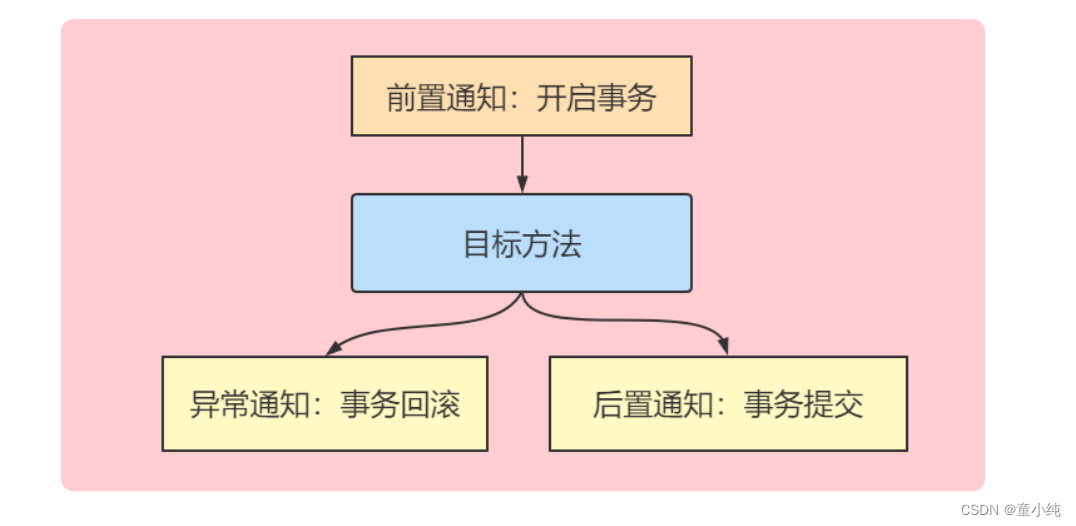
Spring事务_Spring事务管理器

Spring依赖事务管理器进行事务管理,事务管理器即一个通知类, 我们为该通知类设置切点为service层方法即可完成事务自动管理。 由于不同技术操作数据库,进行事务操作的方法不同。如:JDBC提 交事务是 connection.commit() ,MyBatis提交事务是 sqlSession.commit() ,所以 Spring提供了多个事务管理器。

我们使用MyBatis操作数据库,接下来使用 DataSourceTransactionManager 进行事务管理。
1、引入依赖
<!-- 事务管理 --> <dependency><groupId>org.springframework</groupId><artifactId>spring-tx</artifactId><version>5.3.13</version> </dependency> <!-- AspectJ --> <dependency><groupId>org.aspectj</groupId><artifactId>aspectjweaver</artifactId><version>1.8.7</version> </dependency>2、在配置文件中引入约束
xmlns:aop="http://www.springframework.org/schema/aop" xmlns:tx="http://www.springframework.org/schema/tx" http://www.springframework.org/schema/aop http://www.springframework.org/schema/aop/spring-aop.xsd http://www.springframework.org/schema/tx http://www.springframework.org/schema/tx/spring-tx.xsd3、进行事务配置
<!-- 事务管理器 --> <bean id="transactionManager" class="org.springframework.jdbc.datasource.DataSourceTransactionManager"><property name="dataSource" ref="dataSource"></property> </bean> <!-- 进行事务相关配置 --> <tx:advice id = "txAdvice"><tx:attributes><tx:method name="*"/></tx:attributes> </tx:advice> <!-- 配置切面 --> <aop:config><!-- 配置切点 --><aop:pointcut id="pointcut" expression="execution(* com.itbaizhan.service.*.*(..))"/><!-- 配置通知 --><aop:advisor advice-ref="txAdvice" pointcut-ref="pointcut"></aop:advisor> </aop:config>
Spring事务_事务控制的API
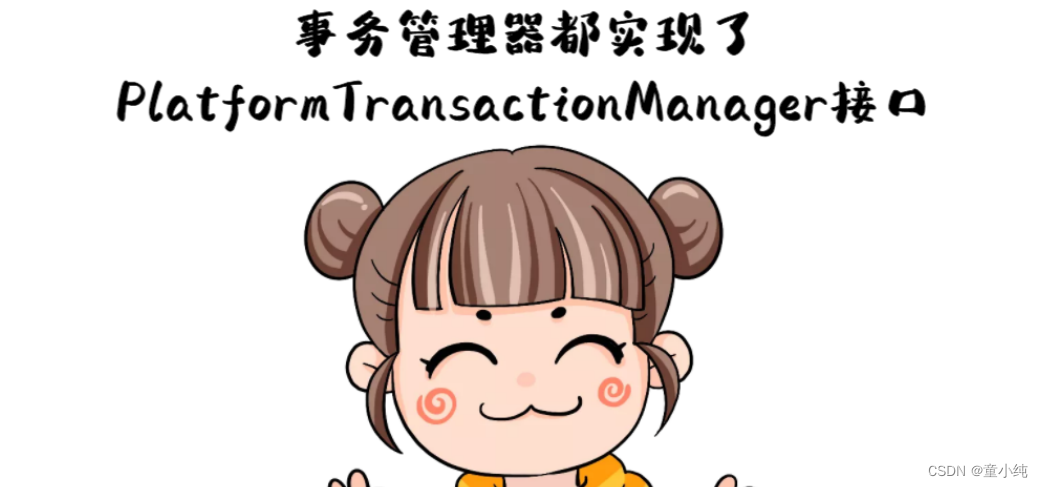
Spring进行事务控制的功能是由三个接口提供的,这三个接口是 Spring实现的,在开发中我们很少使用到,只需要了解他们的作用 即可:
PlatformTransactionManager接口
PlatformTransactionManager是Spring提供的事务管理器接口,所 有事务管理器都实现了该接口。该接口中提供了三个事务操作方法:
1、TransactionStatus getTransaction(TransactionDefinition definition):获取事务状态信息。
2、void commit(TransactionStatus status):事务提交
3、void rollback(TransactionStatus status):事务回滚
TransactionDefinition接口
TransactionDefinition是事务的定义信息对象,它有如下方法:
String getName():获取事务对象名称。
int getIsolationLevel():获取事务的隔离级别。
int getPropagationBehavior():获取事务的传播行为。
int getTimeout():获取事务的超时时间。
boolean isReadOnly():获取事务是否只读。
TransactionStatus接口
TransactionStatus是事务的状态接口,它描述了某一时间点上事务 的状态信息。它有如下方法:
void flush() 刷新事务
boolean hasSavepoint() 获取是否存在保存点
boolean isCompleted() 获取事务是否完成
boolean isNewTransaction() 获取是否是新事务
boolean isRollbackOnly() 获取是否回滚
void setRollbackOnly() 设置事务回滚
Spring事务_事务的相关配置
在<tx:advice> 中可以进行事务的相关配置:
<tx:advice id="txAdvice"><tx:attributes><tx:method name="*"/><tx:method name="find*" readonly="true"/></tx:attributes>
</tx:advice>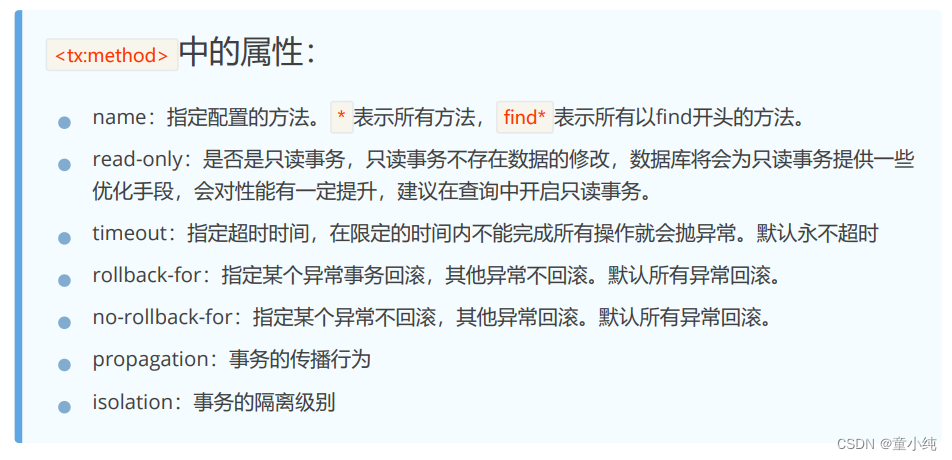
Spring事务_事务的传播行为

事务传播行为是指多个含有事务的方法相互调用时,事务如何在这 些方法间传播。 如果在service层的方法中调用了其他的service方法,假设每次执行 service方法都要开启事务,此时就无法保证外层方法和内层方法处 于同一个事务当中。
// method1的所有方法在同一个事务中 public void method1(){// 此时会开启一个新事务,这就无法保证method1()中所有的代码是在同一个事务中method2();System.out.println("method1"); } public void method2(){System.out.println("method2"); }事务的传播特性就是解决这个问题的,Spring帮助我们将外层方法 和内层方法放入同一事务中。
Spring事务_事务的隔离级别

事务隔离级别反映事务提交并发访问时的处理态度,隔离级别越 高,数据出问题的可能性越低,但效率也会越低。


Spring事务_注解配置声明式事务
Spring支持使用注解配置声明式事务。用法如下:
1、注册事务注解驱动
<!-- 注册事务注解驱动 --> <tx:annotation-driven transaction-manager="transactionManager"></tx:annotation-driven>2、在需要事务支持的方法或类上加@Transactional
@Service // 作用于类上时,该类的所有public方法将都具有该类型的事务属性 @Transactional(propagation = Propagation.REQUIRED,isolation = Isolation.DEFAULT) public class AccountService {@Autowiredprivate AccountDao accountDao;/*** 转账* @param id1 转出人id* @param id2 转入人id* @param price 金额*/// 作用于方法上时,该方法将都具有该类型的事务属性@Transactional(propagation = Propagation.REQUIRED,isolation = Isolation.DEFAULT)public void transfer(int id1, int id2,double price) {// account1修改余额Account account1 = accountDao.findById(id1);account1.setBalance(account1.getBalance()-price);accountDao.update(account1);int i = 1/0; // 模拟转账出错// account2修改余额Account account2 = accountDao.findById(id2);account2.setBalance(account2.getBalance()+price);accountDao.update(account2);} }3 配置类代替xml中的注解事务支持:在配置类上方写 @EnableTranscationManagement
@Configuration @ComponentScan("com.itbaizhan") @EnableTransactionManagement public class SpringConfig {@Beanpublic DataSource getDataSource(){DruidDataSource druidDataSource = new DruidDataSource();druidDataSource.setDriverClassName("com.mysql.jdbc.Driver");druidDataSource.setUrl("jdbc:mysql:///spring");druidDataSource.setUsername("root");druidDataSource.setPassword("root");return druidDataSource; }@Beanpublic SqlSessionFactoryBean getSqlSession(DataSource dataSource){SqlSessionFactoryBean sqlSessionFactoryBean = new SqlSessionFactoryBean();sqlSessionFactoryBean.setDataSource(dataSource);return sqlSessionFactoryBean;}@Beanpublic MapperScannerConfigurer getMapperScanner(){MapperScannerConfigurer mapperScannerConfigurer = new MapperScannerConfigurer();mapperScannerConfigurer.setBasePackage("com.itbaizhan.dao");return mapperScannerConfigurer;}@Beanpublic DataSourceTransactionManager getTransactionManager(DataSource dataSource){DataSourceTransactionManager dataSourceTransactionManager = new DataSourceTransactionManager();dataSourceTransactionManager.setDataSource(dataSource);return dataSourceTransactionManager;} }


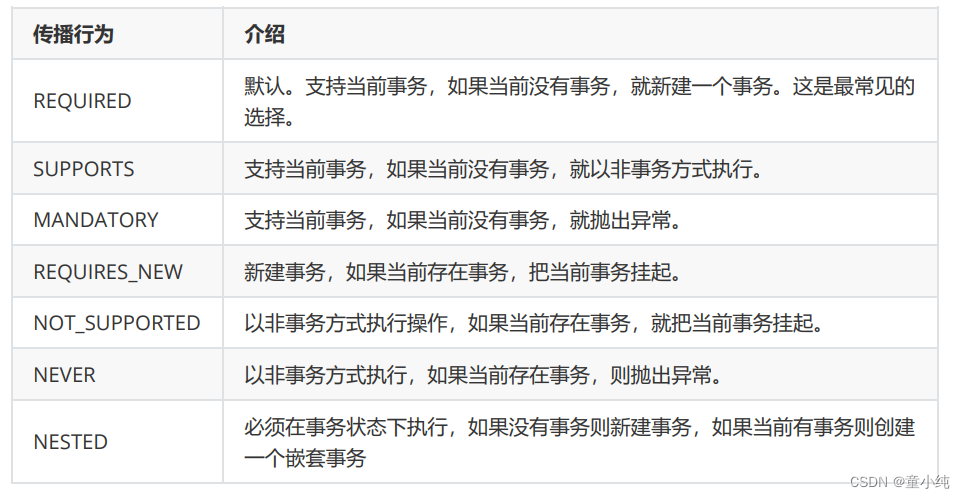


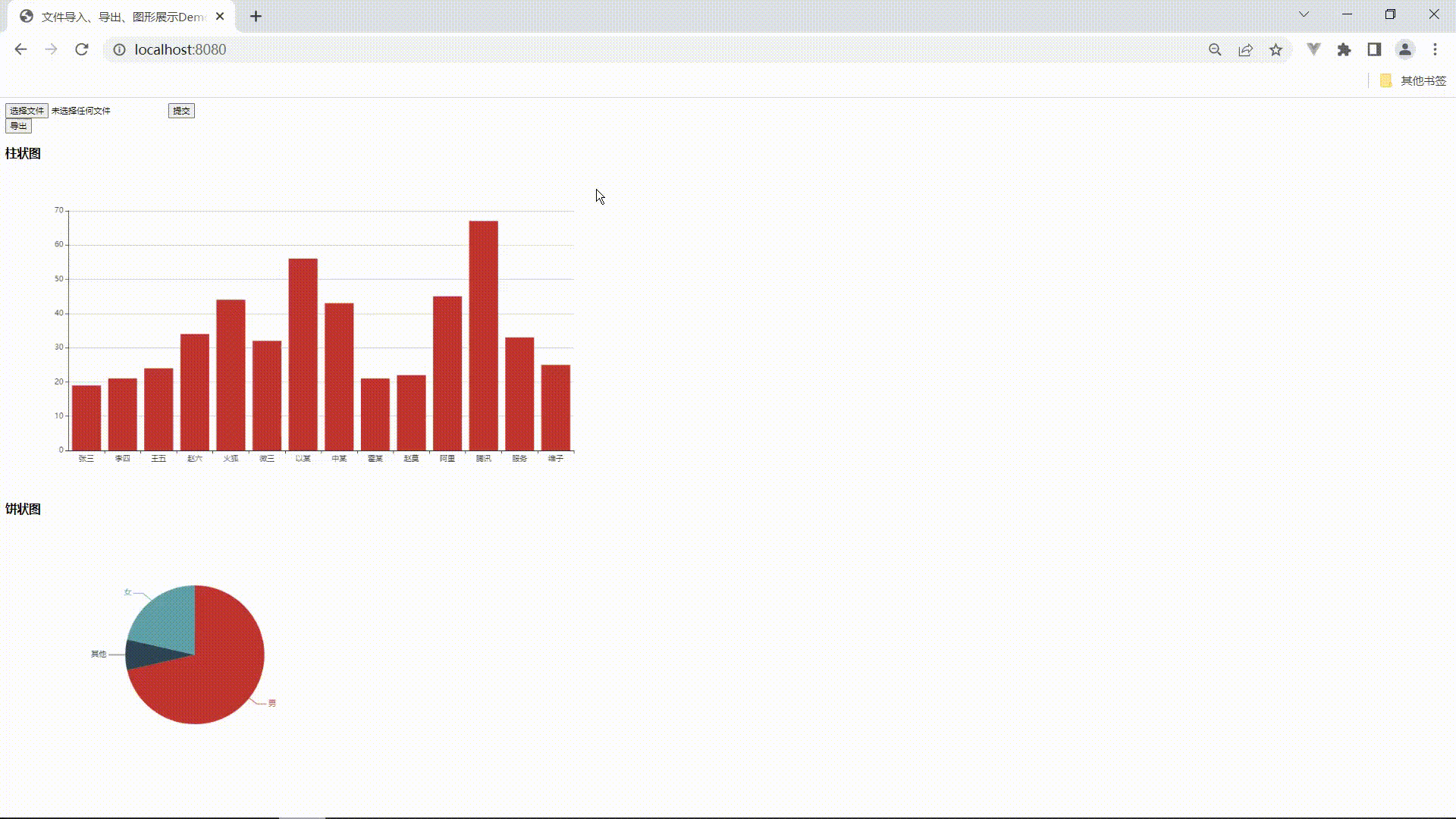




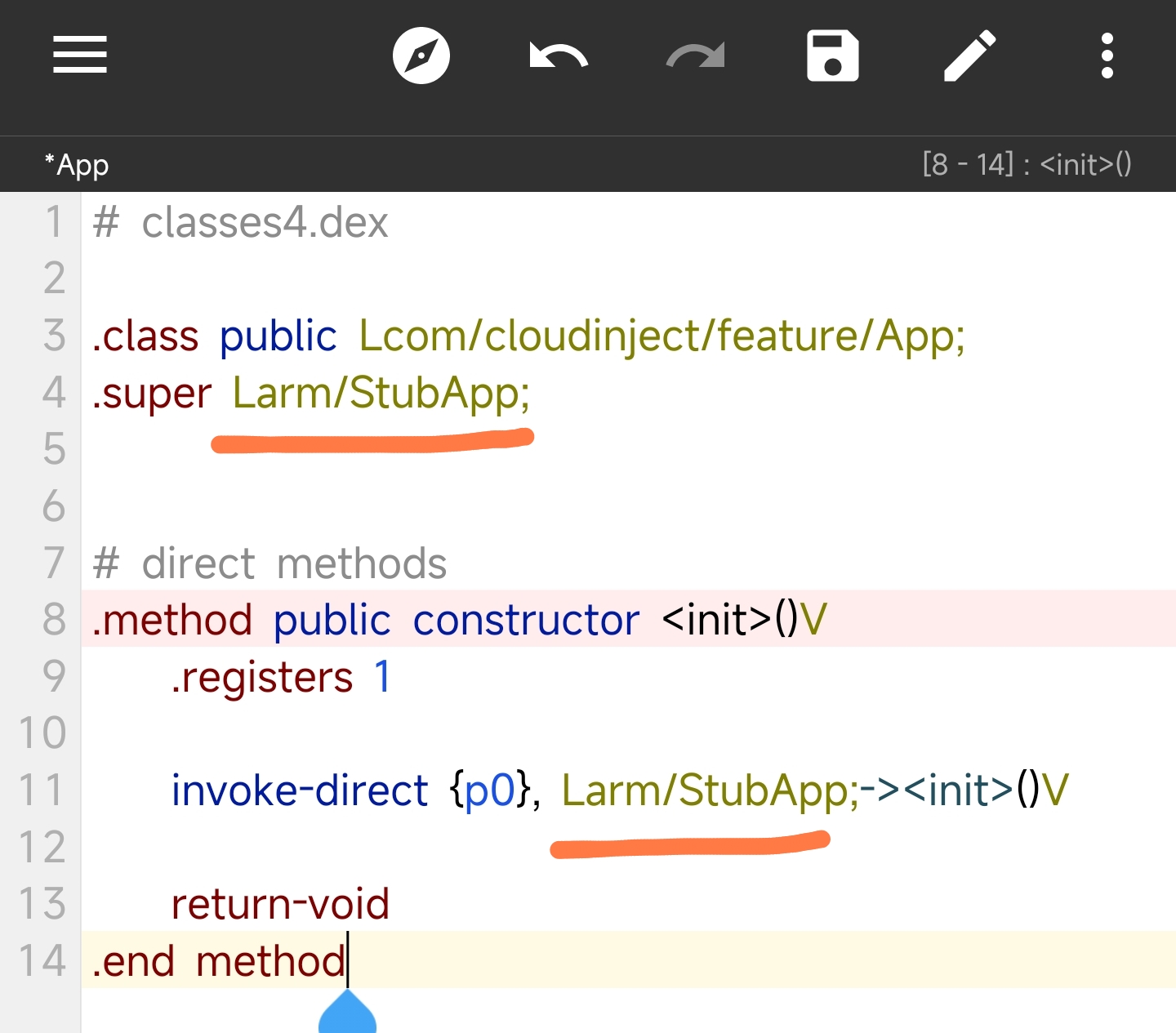

![[附源码]计算机毕业设计springboot基于Java的失物招领平台](https://img-blog.csdnimg.cn/28d3eacc3739404b8a4c2f26476d63ff.png)
